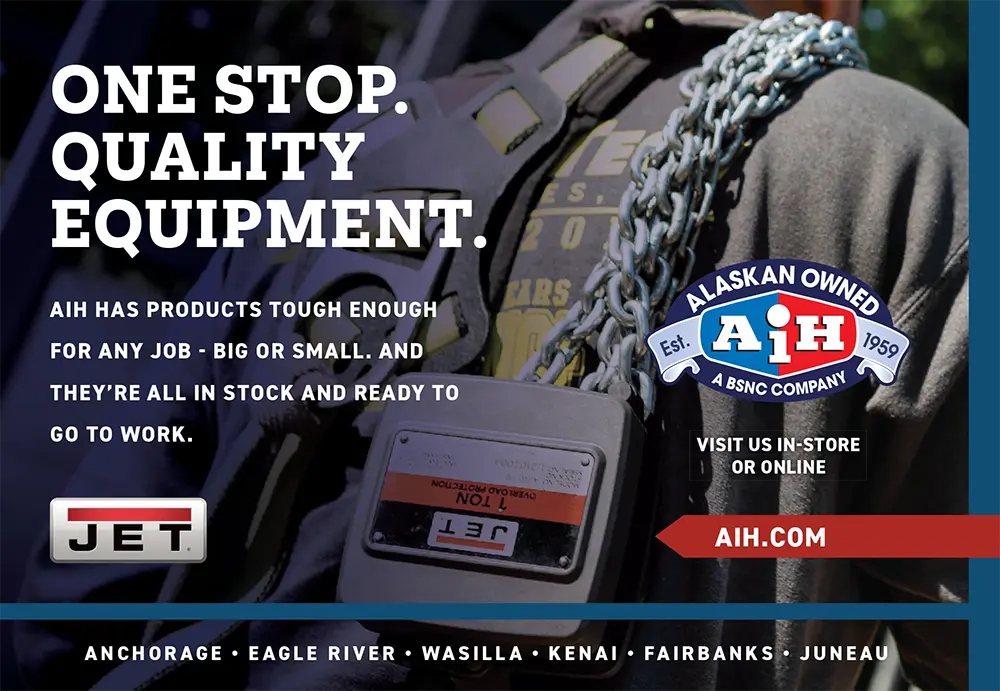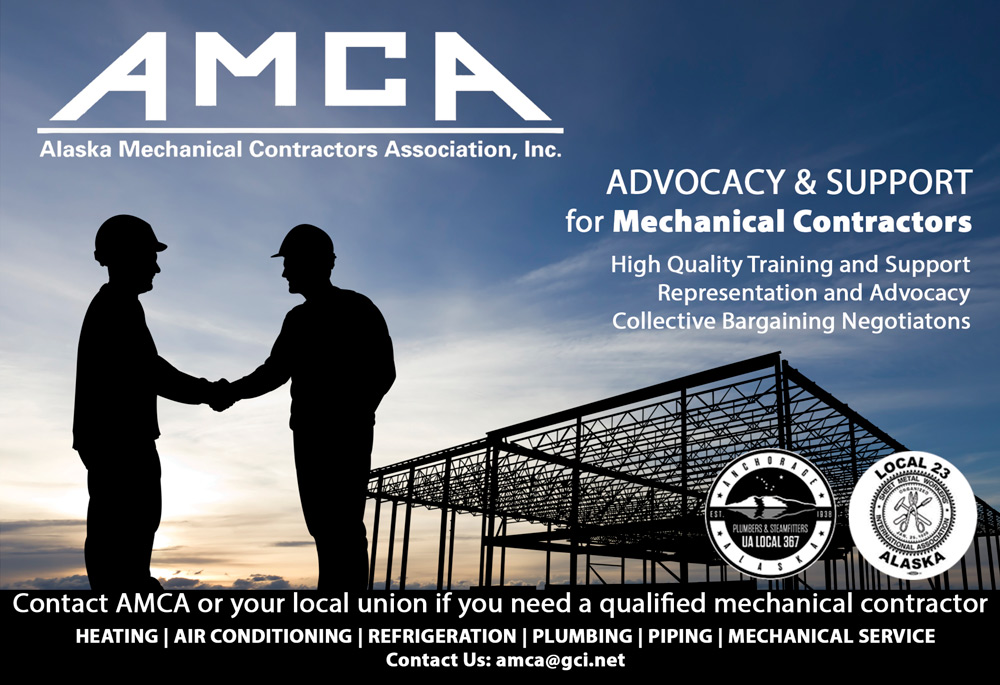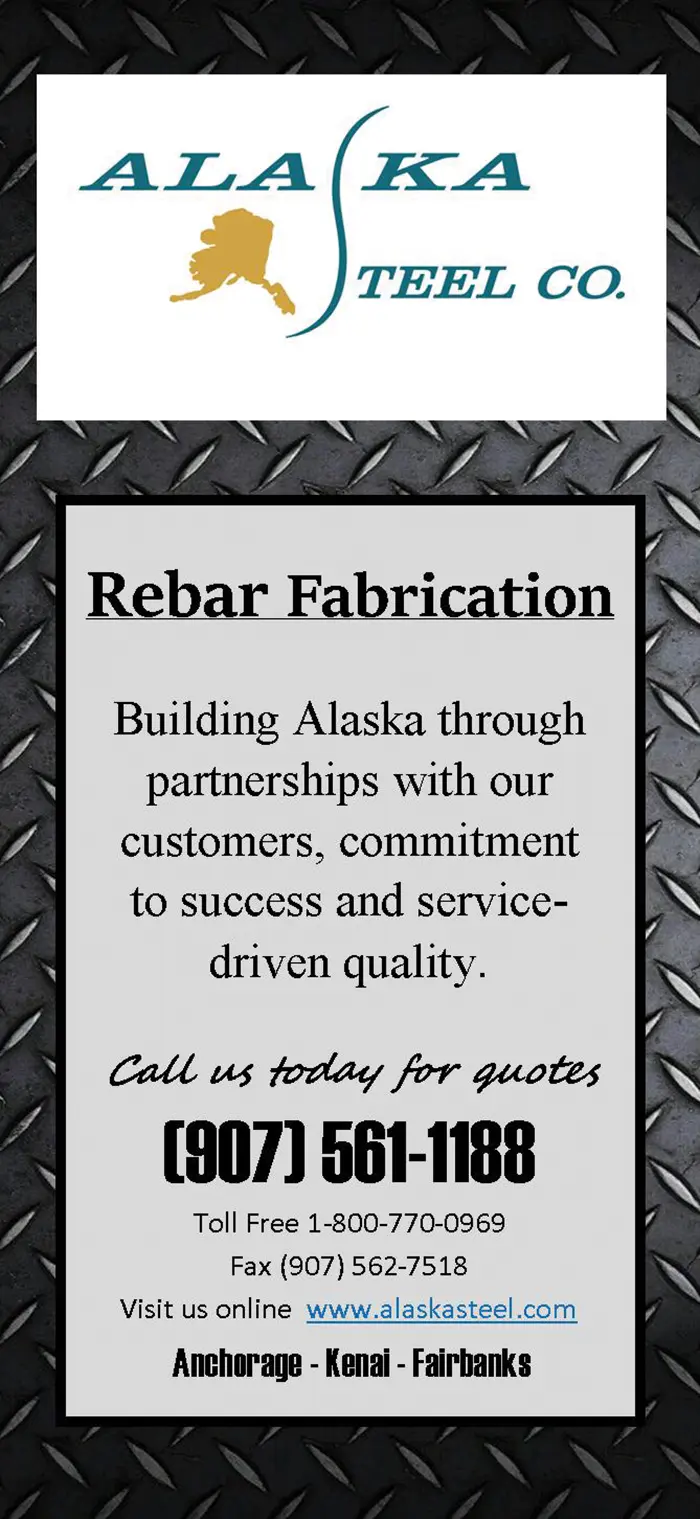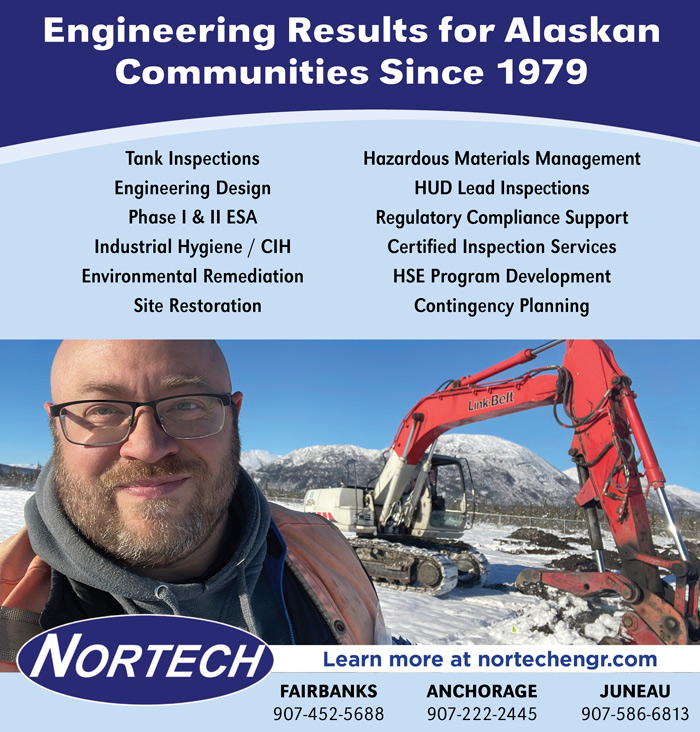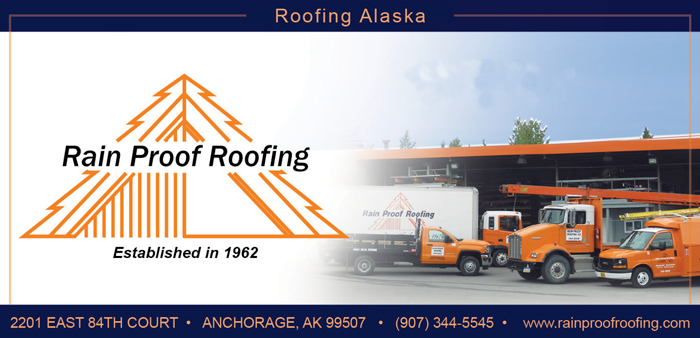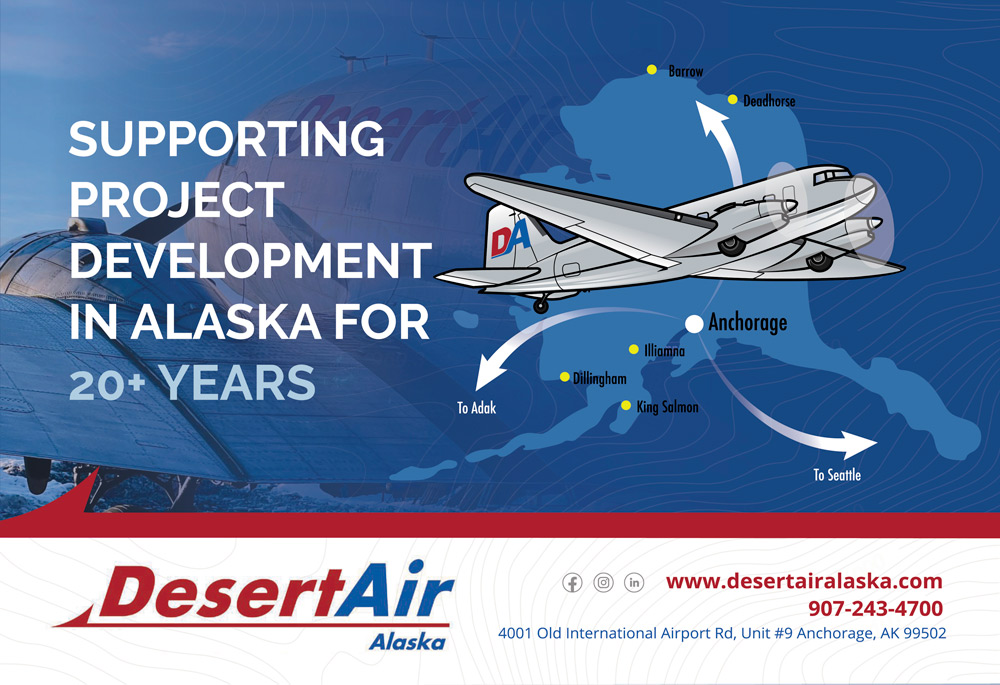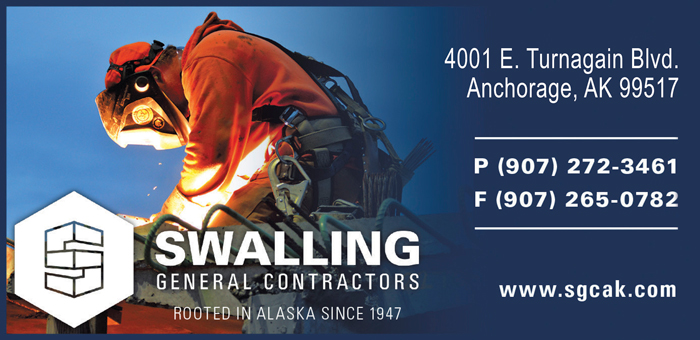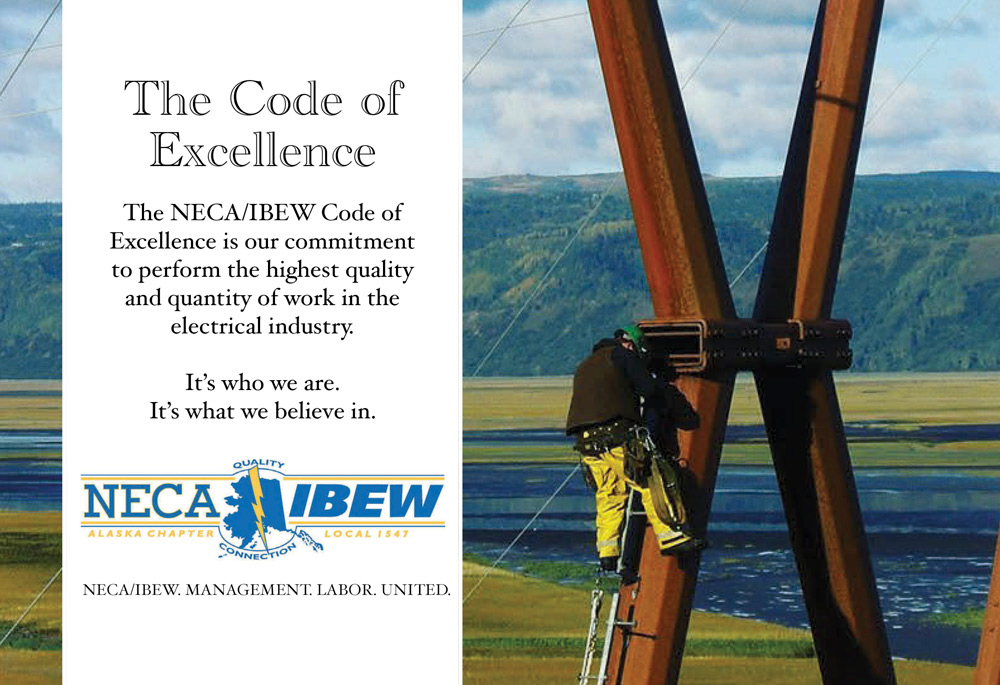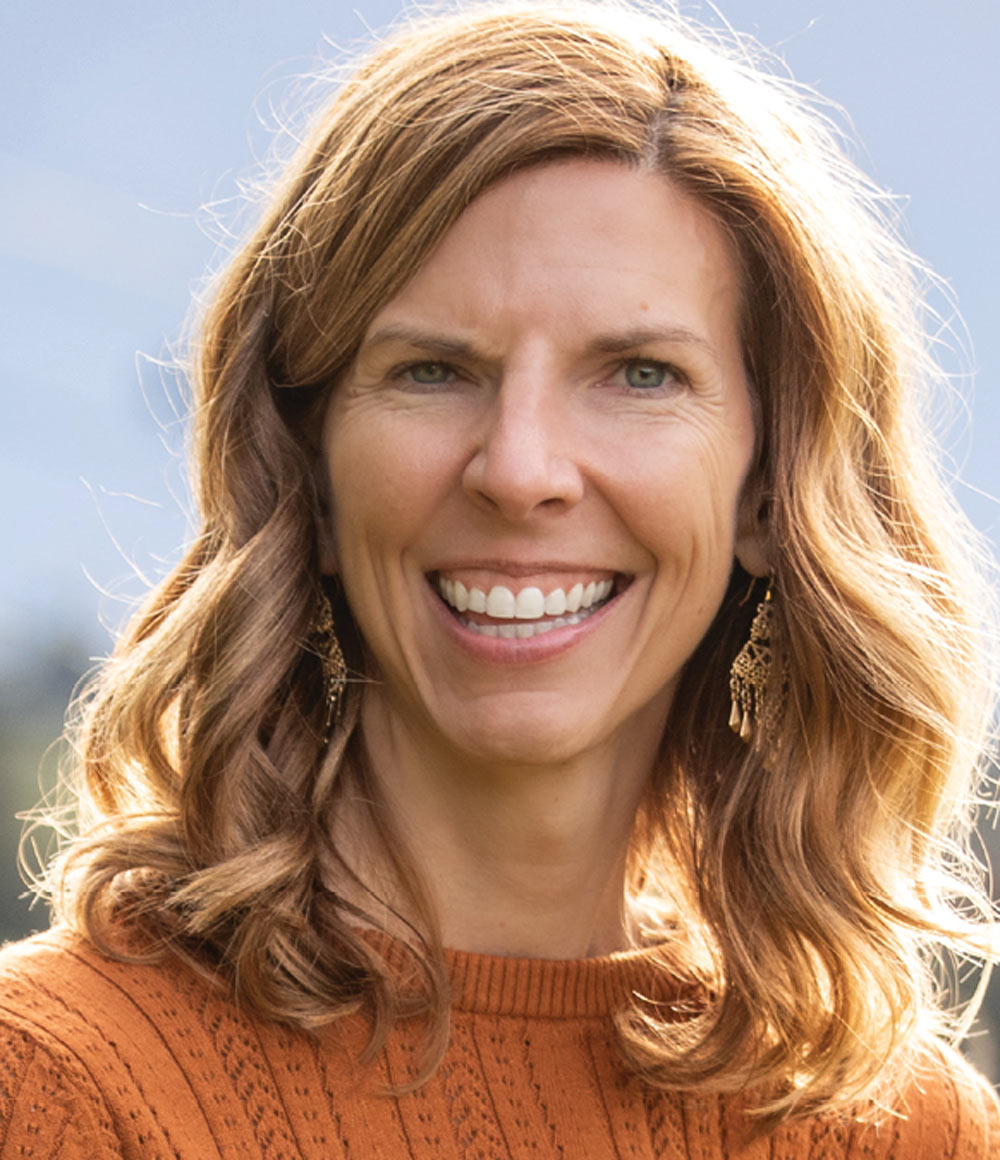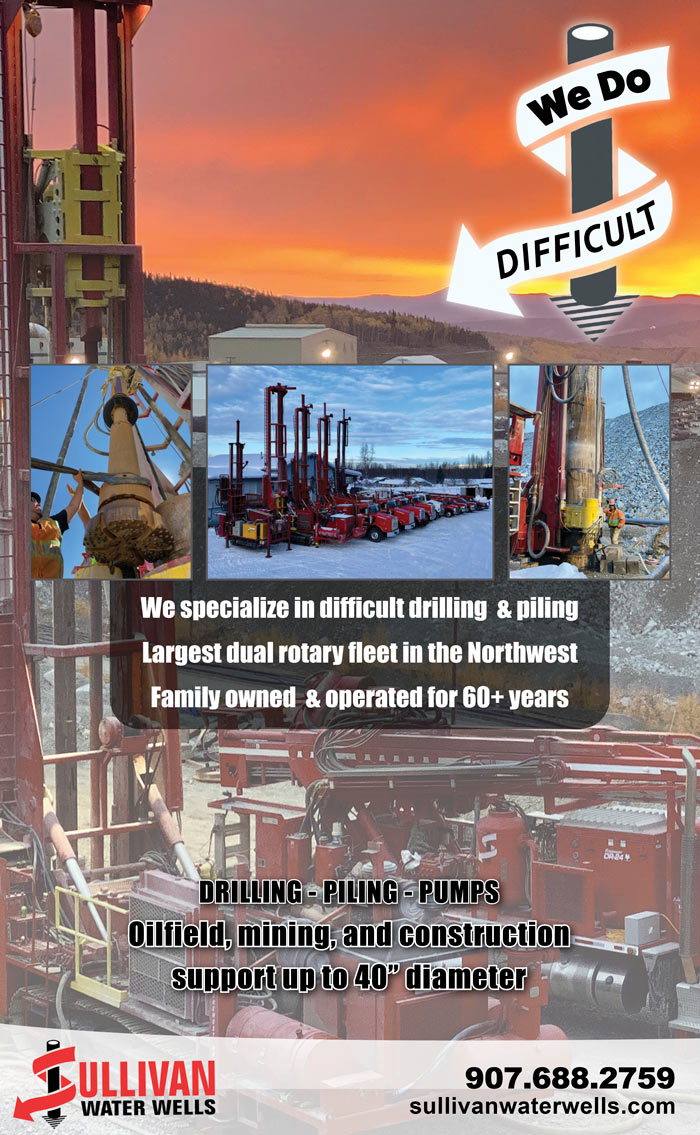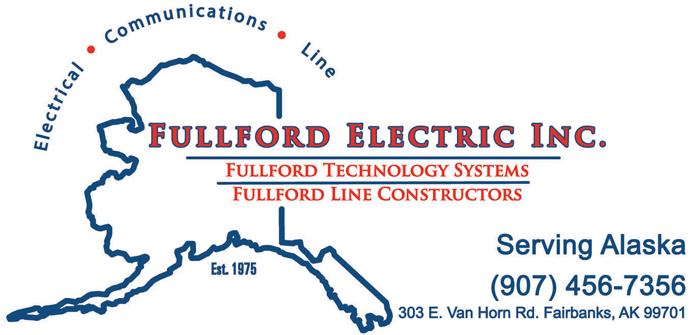Associated General
Contractors of Alaska

Associated General
Contractors of Alaska

8005 Schoon St.
Anchorage, AK 99518
907-561-5354
Fax: 907-562-6118
www.agcak.org
ChemTrack Alaska, Inc.
Pearl-Grace Pantaleone
HDR Alaska Inc.
Alicia Amberg
Associated General Contractors of Alaska
Christine A. White
R&M Consultants, Inc.
Heather Sottosanti
Big State Mechanical, LLC
Saigen Harris
F&W Construction, Inc.
Johnathon Storter
Meridian Management, Inc.
Annie Gardner
Knik Construction Co., Inc.
Tasha Anderson
Managing Editor
Rindi White
Editor
Monica Sterchi-Lowman
Art Director
Fulvia Lowe
Art Production
James K Brown
Graphic Designer
BUSINESS STAFF
Charles Bell
VP Sales & Marketing
907-257-2909 cbell@akbizmag.com
Janis J. Plume
Senior Account Manager
907-257-2917 janis@akbizmag.com
Christine Merki
Senior Account Manager
907-257-2911 cmerki@akbizmag.com
501 W. Northern LIghts Blvd., Ste 100
Anchorage, AK 99503
The Alaska Contractor is published by Alaska Business Publishing Co. Inc. for the Associated General Contractors of Alaska. Contents of the magazine are not necessarily endorsed by AGC of Alaska or Alaska Business Publishing Co. All rights reserved. Copyright 2025 by the Associated General Contractors of Alaska. For information about articles in this edition or for permission to reproduce any portion of it, contact Alaska Business Publishing Co.
Photo provided by SECON
Design by James K Brown


8005 Schoon St.
Anchorage, AK 99518
907-561-5354
Fax: 907-562-6118
www.agcak.org
ChemTrack Alaska, Inc.
Pearl-Grace Pantaleone
HDR Alaska Inc.
Alicia Amberg
Associated General Contractors of Alaska
Christine A. White
R&M Consultants, Inc.
Heather Sottosanti
Big State Mechanical, LLC
Saigen Harris
F&W Construction, Inc.
Johnathon Storter
Meridian Management, Inc.
Annie Gardner
Knik Construction Co., Inc.
Tasha Anderson
Managing Editor
Rindi White
Editor
Monica Sterchi-Lowman
Art Director
Fulvia Lowe
Art Production
James K Brown
Graphic Designer
BUSINESS STAFF
Charles Bell
VP Sales & Marketing
907-257-2909 cbell@akbizmag.com
Janis J. Plume
Senior Account Manager
907-257-2917 janis@akbizmag.com
Christine Merki
Senior Account Manager
907-257-2911 cmerki@akbizmag.com
501 W. Northern LIghts Blvd., Ste 100
Anchorage, AK 99503
The Alaska Contractor is published by Alaska Business Publishing Co. Inc. for the Associated General Contractors of Alaska. Contents of the magazine are not necessarily endorsed by AGC of Alaska or Alaska Business Publishing Co. All rights reserved. Copyright 2025 by the Associated General Contractors of Alaska. For information about articles in this edition or for permission to reproduce any portion of it, contact Alaska Business Publishing Co.
Photo provided by SECON
Design by James K Brown

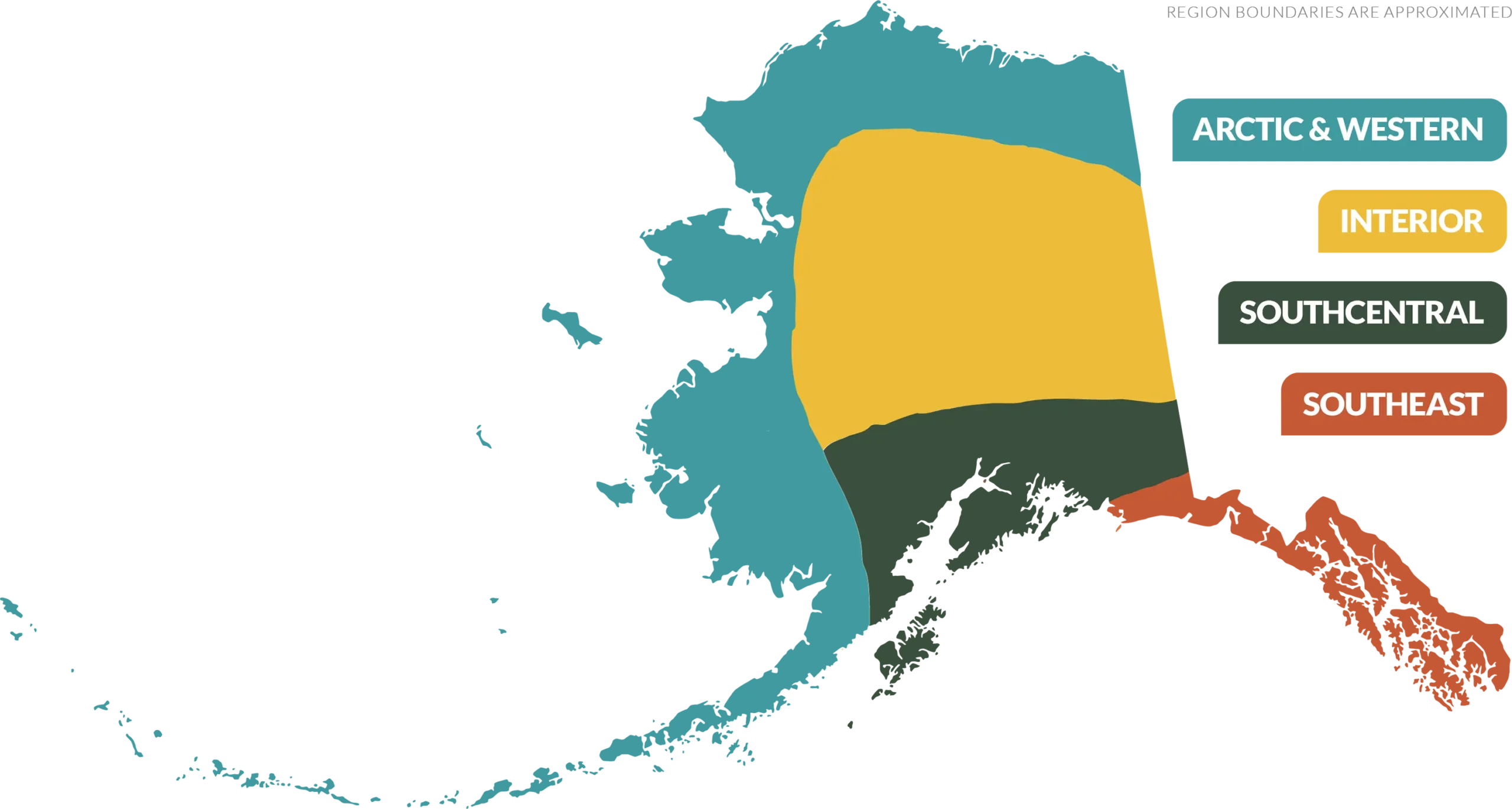



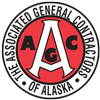 AGC MEMBER
AGC MEMBER
 Qayaq Construction LLC
Qayaq Construction LLC$5,944,564
Minto Energy System Upgrades On Site Construction
 STG Incorporated
STG Incorporated
$3,786,350
Bulk Fuel Utility Upgrade Project
Prism Design & Construction
$1,527,609
Hopson Middle School Windows Replacement & Upgrades
Concor LLC
$1,487,000
Boiler Replacement at FAA Housing Complex
Alaska Commercial Development Group
$1,198,028
SMCSD Teacher Housing Duplex
 Kuchar Construction, LLC
Kuchar Construction, LLC
$955,000
Selawik Wind Turbine Removal
 Alaska Demolition, LLC
Alaska Demolition, LLC
$268,034
Residential Water Service Line & Sewage Holding Tank Installations – Galena
 Frostline Drilling and Construction LLC
Frostline Drilling and Construction LLC
$196,660

 GHEMM Company, LLC
GHEMM Company, LLC$1,037,500
Noel Wien Library Parking Lot Repair
 Great Northwest, Inc.
Great Northwest, Inc.
$621,814
Fairbanks Bike Lane Striping and Signing (TAP)
 Exclusive Paving
Exclusive Paving
$459,939
Mowing and Planting Services at the Chena River Lakes Flood Control Project
True North Pest Control, LLC
$403,320
Utilities University Park Condensate Pipe Repair
 Pro Built LLC
Pro Built LLC
$396,275
4th and State Storm Drain Extension
 Exclusive Paving
Exclusive Paving
$339,913
Lathrop High School Kitchen Hood Replacement
 Aaron Plumbing & Heating, Co.
Aaron Plumbing & Heating, Co.
$304,500
Herbicide Application Services at the Chena River Lakes Flood Control Project
True North Pest Control, LLC
$263,040

 Great Northwest, Inc.
Great Northwest, Inc.$11,301,406
Craig Elementary and Middle School Renovations/Upgrades
 MCG Constructors Inc.
MCG Constructors Inc.
$11,247,000
Aurora Harbor Rebuild – Phase IV
 Western Marine Construction, Inc.
Western Marine Construction, Inc.
$7,589,700
High School/Middle School Roof Replacement and High School Entry/Office Renovation
CBC Construction, Inc.
$3,706,594
The New Pilot Point Community Center for Pilot Point Tribal Council
Yukon West Defense Technologies LLC
$3,110,230
Mendenhall Wastewater Treatment Plant Dried Biosolids Crusher System & Building Modifications
Dawson Construction, Inc.
$1,645,415
Glenn Highway MP 143-154 Resurfacing
 Great Northwest, Inc.
Great Northwest, Inc.
$1,484,300
Starlite Court Reconstruction
 North40 Construction Corporation
North40 Construction Corporation
$819,965
Hank Harmon Public Range Improvements
Island Contractors, Inc.
$810,908
Civic Center Green Room Renovation
Barnett Building LLC
$701,840
Cruise Dock Water and Fire Protection
Harri Plumbing and Heating, Inc.
$548,934
Wastewater Generator Replacements Phase 1
 Ever Electric, Inc. dba Island Electric
Ever Electric, Inc. dba Island Electric
$298,598
USCG Air Station Sitka Housing Carpet and Installation Services
Michael Davidson
$240,000
Residential Well & Septic System Installation – Glennallen
 Frostline Drilling and Construction LLC
Frostline Drilling and Construction LLC
$183,390
Schoenbar Park Parking Lot Replacement
 Colaska, Inc. dba SECON
Colaska, Inc. dba SECON
$153,880
Letnikof Cove Float Removal
H.L. Tormey LLC
$143,000
Cordova Impound Lot and Transfer Facility Expansion
Cordova Powersports
$133,000
RAM Roof Replacement Drainage Improvements
B&R Fish By Products, Inc.
$125,000
Residential Septic System Installations – Valdez
Blackwell Pump Services
$109,000

 ASRC Earthworks LLC
ASRC Earthworks LLC$7,303,209
Eklutna Water Treatment Facility Motor Control Center Upgrade
 Sturgeon Electric Co., Inc.
Sturgeon Electric Co., Inc.
$4,829,450
Alaska Veterans & Pioneers Home Roof Replacement
Brick and Birch Homes LLC
$3,328,048
Soldotna High School Siding
 Blazy Construction Inc.
Blazy Construction Inc.
$2,186,520
Gruening Middle School Boiler Room Improvements
 Roger Hickel Contracting, Inc.
Roger Hickel Contracting, Inc.
$2,148,700
LHD Aircraft & Lakeshore Drive Rehabilitation
 QAP
QAP
$2,073,368
ANC RON 12-14 Rehabilitation
 Granite Construction Co.
Granite Construction Co.
$2,044,493
Fabrication and Supply of 2-79′ Deck Plate Girder Spans and 1-30′ Rolled Beam Span for Bridge 114.3
Jesse Co.
$2,010,036
Road Service Area 16 South Colony Annual Road Maintenance
McKenna Bros Paving Inc
$1,831,460
Baxter Family Housing – Civil Construction
 Caliber Construction Alaska
Caliber Construction Alaska
$1,488,115
Chugiak Pool Renovation
 Roger Hickel Contracting, Inc.
Roger Hickel Contracting, Inc.
$1,446,771
Ravenwood ES Loading Dock Awning
 Eklutna Construction & Maintenance, LLC
Eklutna Construction & Maintenance, LLC
$1,301,784
Old Tyonek Creek at Airport Road and Tyonek Timber Road Fish Passage Improvements
Western Construction & Equipment
$1,021,225
Road Service Area 20 Greater Willow Annual Road Maintenance
McKenna Bros Paving Inc.
$902,884
Telephone Ave. Cable Replacement Project
 Sturgeon Electric Co., Inc
Sturgeon Electric Co., Inc
$858,951
McKenna Bros Paving Inc.
$829,879
Road Service Area 29 Greater Talkeetna Annual Road Maintenance
Alaska Resource Group, LLC
$796,720
Northwood St. Maintenance Storage Facility Roof Renovation
Brad Zweifel Co., Inc.
$725,845
Road Service Area 26 Greater Butte Annual Road Maintenance
McKenna Bros Paving Inc.
$700,139
PWSC GHB Parking Lot Update
 Caliber Construction Alaska
Caliber Construction Alaska
$689,365
College Gate Elementary School Pedestrian Improvements
JTA Construction, LLC
$668,128
ANC Runway 7R Concrete Joint Repairs
Brick and Birch Homes LLC
$608,789
Hope School Roof Replacement
H Construction LLC
$537,761
Construct Melanie Lane & Brian Drive Street Improvements
 Dirtworks, Inc.
Dirtworks, Inc.
$484,789
2025 Apron Pavement Maint.
CR Contracting, LLC
$466,460
Deep Creek SRS Facility Rehab.
Foster Construction LLC
$450,722
Anchorage Railroad Crossing Striping Phase II
 Granite Construction Co.
Granite Construction Co.
$436,950
Provide Campbell Airstrip Road Clearing – Shaded Fuel Breaks
Alaska Land Clearing Contractors LLC
$374,500
Hidden Lake Septic System Kenai NWR Alaska
AK Built Construction & Design
$362,200
Furnish Winter Aggregate to the Municipality of Anchorage, Eagle River Street Maintenance
Northern Gravel & Trucking LLC
$290,000
Road Service Area 30 Trapper Creek Annual Road Maintenance
Alaska Resource Group, LLC
$274,145
Spernak & Son LLC
$264,350
Road Service Area 19 Lazy Mountain Annual Road Maint.
Battleground LLC
$189,867
Residential Well & Septic System Installation – Healy
Pioneer Peak Industries, LLC
$181,000
Provide Vactor Cleaning Services on an “As-Required” Basis to the Municipality of Anchorage
Smithsons
$172,375
Supply & Install Fencing & Entrance Gate at Central Landfill
Mt. McKinley Fence Company of Mat-Su Valley
$169,596
Russian Jack Community Council Vertical Traffic Calming
 GMG General, Inc.
GMG General, Inc.
$166,832
Kenai River Ctr. Roof Replacement
Building Specialties Inc
$165,975
Egan Ctr. Lighting Control Upgrades
Premier Electric LLC
$162,000
Provide Street Maintenance Structures for Multiple Projects to the Municipality of Anchorage, Eagle River Street Maintenance
D&S Concrete Inc
$149,547
Furnish Signage Materials to the Municipality of Anchorage, Public Works Department
Sign Solutions USA
$147,133
Nikiski North Star Elementary Windows Replacement
R Squared Contracting and Engineering, LLC
$133,340
North Peninsula Recreation Service Area Pool Flooring Renovation/Remodel
R Squared Contracting and Engineering, LLC
$126,918
Provide Annual Generator Testing and Maintenance Services
Pacific Power Group
$101,955
Gym Floor Refinishing Services
AK Premier Finishing and Supply
$100,878





MESSAGE
ssociated General Contractors, or AGC, of Alaska is built on the strength of its members—contractors, suppliers, and professionals who bring their insight, experience, and passion to the table. One of the most impactful ways members can shape the future of our industry and association is through active participation on AGC committees. Now more than ever, we are looking for new voices, fresh perspectives, and committed individuals to help lead the charge.
We understand that many members are busy running companies, managing teams, and meeting deadlines. But that’s exactly why your voice matters. You see the challenges firsthand, and you likely have ideas and insights that could benefit others in the industry. Joining a committee gives you a platform to share those ideas and help shape AGC’s work on behalf of all members.
You don’t need decades of experience or a long history with AGC to make a difference. In fact, some of the most valuable contributions come from those who bring a fresh lens and a willingness to ask different questions. Whether you’re a seasoned project manager, a new estimator, or running your own small business, there’s a seat at the table for you.
- The Construction Leadership Committee, or CLC, is ideal for emerging professionals looking to build their leadership skills, grow their networks, and take on greater roles within AGC and the industry at large. The CLC hosts events, supports professional development initiatives, and helps ensure the next generation of leaders has the tools and support they need to succeed.
- Like reading this magazine? Then consider joining AGC’s Magazine Editorial Board. The Editorial Board oversees AGC’s publication of The Alaska Contractor magazine. This committee works to ensure our communications reflect the work, voice, and concerns of our members. Help us highlight the work AGC members do statewide and ensure our messaging remains clear, relevant, and compelling.
Whether you’re interested in shaping policy positions, supporting workforce development initiatives, or growing AGC’s membership, there’s a committee for you.
If you’ve ever asked, “Why doesn’t AGC do X?” or “Wouldn’t it be great if we had Y?” being on a committee is your chance to be part of the solution. Your input helps shape the resources, events, and advocacy that AGC offers to all members.

s Alaska’s construction season ramps up, it’s time to refocus on the core priorities that shape our industry. From reinforcing our unwavering commitment to workforce safety, highlighting exciting opportunities, and recapping our recent advocacy efforts in Washington, D.C., it’s safe to say we’ve been busy. But as everyone in the industry knows, “busy is good” and the work we do together paves the way for a safer, stronger, and more prosperous future for Alaska’s construction community.
I can’t emphasize enough how important it is to respect these spaces and people working in them. Be safe, slow down, pay attention, and follow the rules. We all share responsibility in ensuring that every worker and every driver gets home safely at the end of the day. As we move into this busy season, I encourage you to promote a safety-first culture on every job site and every road you travel. Lastly, share this message with your family and friends—doing so could save a life.
During Agency Day, we received promising updates on projects poised to provide Alaska’s construction industry with a massive shot in the arm. First, progress made on the Alaska Industrial Development and Export Authority’s Ambler Road project is noteworthy. We learned that multiple Construction Manager/General Contractor (CM/GC) contracts for this significant infrastructure project are expected to be out for bid this year. The 211-mile road will provide access to almost 600,000 acres of state mining claims. Since 2020, more than $80 million has been invested in Alaska for this project. This project is estimated to create 2,777 direct jobs with $286 million in wages annually during mine construction and 360 direct jobs annually during road construction.
Additionally, the discussion around the Alaska LNG/Glenfarne natural gas project incited excitement amongst attendees. This effort to monetize Alaska’s vast North Slope gas resources while providing Alaskans with affordable energy would create countless opportunities for AGC members. The current plan is to build an 807-mile pipeline from the North Slope to Southcentral Alaska, as well as facilities to process the gas into liquid for overseas shipment.
The project is planned in two main phases: Phase 1 focuses on building the pipeline itself, estimated to cost $10.8 billion. Phase 2 involves building the gas treatment and LNG export facilities at an estimated cost of $33 billion. Glenfarne will serve as a major partner, taking on a 75 percent share and financial responsibility. If it moves forward, Alaska is likely to experience a building boom similar to when the Trans Alaska Pipeline System was constructed decades ago. To say we are keeping a close eye on this exciting opportunity is an understatement.
Discussions during “Alaska on the Hill” cover topics central to Alaska’s construction industry. These include federal funding for infrastructure projects, responsible resource development, environmental regulations, and policies that support economic growth. Supporting “Alaska on the Hill” allows us to join forces with our trade organization partners to advocate for federal decisions that benefit all industries, including construction. We make quite the splash when we all show up together with the same messages.

PO Box 73576, Fairbanks, AK 99707
907-385-2211
chris.bsr@outlook.com
www.bsrinfo.com
3035 C St., Anchorage, AK 99503
907-222-5200
tcline@haskellcorp.com
www.haskellcorp.com
Patrick McAnally, General Manager
3900 C St., Anchorage, AK 99503
907-339-5900
pmcanally@asrcconstruction.com
www.asrcconstruction.com
Meg Nordale, President
Harold Baysinger, General Manager
3861 Schacht St., Fairbanks, AK 99701
907-452-5191
info@ghemmsolutions.com
6200 Blackberry St., Anchorage, AK 99502
907-602-9636
infinity.electric.ak@gmail.com
PO Box 230405, Anchorage, AK 99523
907-317-6488
ssaloka@salokainc.com
www.salokainc.com
3340 Arctic Blvd., Ste. 202, Anchorage, AK 99503
907-600-1751
clyde@49thfreight.com
www.49thfreight.com
3852 N. Clark-Wolverine Rd., Palmer, AK 99645
907-521-4676
gbrewer@alaskaearthworks.com
Arnold Akers, Manager
PO Box 2408, Palmer, AK 99645
907-745-4049
office@alaskafencemanufacturing.com
8907 Yandukin Dr., Juneau, AK 99801
907-523-3597
erica@flyalaskaseaplanes.com
www.flyalaskaseaplanes.com
200 E. 100th Ave., Anchorage, AK 99515
907-375-1280
aesping@builderschoice.us.com
www.asrcconstruction.com
325 Chestnut St., Ste. 700, Philadelphia, PA 19106
215-969-1000
kayla.hall@cbiz.com
www.compudata.com
Haley Gamache, Training and Operations Manager
2217 E. Tudor Rd., Ste. 16, Anchorage, AK 99507
907-301-5155
info@frontiersafetyandsupply.com
www.frontiersafetyandsupply.com
6001 E. Chinook Ave., 1D, Wasilla, AK 99654
360-209-2156
henry@hprecruitment.com
www.hprecruitment.com
3821 Amber Bay Loop, Anchorage, AK 99515
907-290-4339
Alaskafpe@gmail.com
PO Box 111207, Anchorage, AK 99511
907-677-2601
jstorter@meridianak.com
335 Athena Dr., Athens, GA 30601
832-566-1416
cody.huff@skaps.com
www.skaps.com
Amber Schoff, Account Executive
5333 Fairbanks St., Ste. B, Anchorage, AK 99518
907-563-2242
Daniel.Hart@siemens.com
Amber.Schoff@siemens.com
www.siemens.com
11400 SE 8th St., Ste. 380
Bellevue, WA 98004
206-326-4284
Tbelling@travelers.com
www.travelers.com
3875 Geist Rd., Ste. E#432
Fairbanks, AK 82801
907-590-9519
e.denty@ua-pm.com
www.ua-pm.com


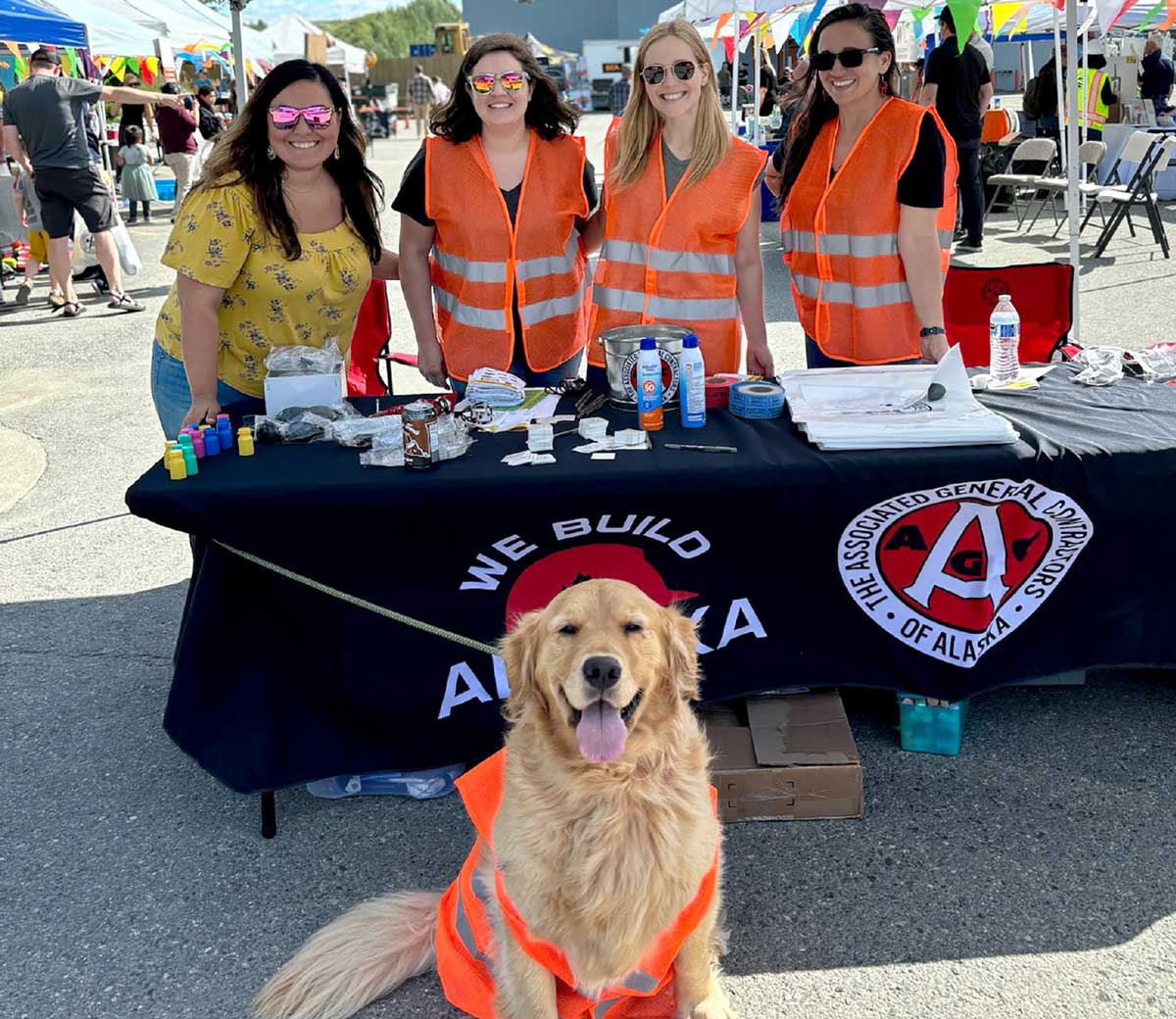
Photo provided by AGC of Alaska


ummer is in full swing and, as Alaskans, we know what that means: construction. For the casual driver, that might mean a slight delay on the way to or from work, or perhaps a longer delay on the way to a camping or fishing trip. But to construction industry workers, summer means trying to do a job while hundreds—or perhaps thousands—of people stream through their workplace. Most people are polite, respectful, and focused on their own goals. Some might be distracted—by technology, by traveling companions, by the surrounding scenery, by preoccupying thoughts, or myriad other reasons. Speed and distracted driving are the top two causes of accidents in work zones.
Notably, it’s not highway workers who are most often injured or killed in work zone accidents—it’s drivers and passengers in personal vehicles. In 2022, 742 drivers and their passengers died in work zones, according to the National Highway Transportation Safety Administration. The National Work Zone Safety Clearinghouse reports that, in 2022, the most recent year for which data is available, there were 96,000 estimated total work zone crashes, 891 total work zone fatalities and 37,000 work zone injuries.
Although the data is sobering, there is reason for hope: the Bureau of Labor Statistics Census of Fatal Occupational Injuries reported that fatal highway worker injury numbers have decreased from 124 in 2018 to 94 in 2022.
The week kicked off with Work Zone Safety Training Day, which emphasized the importance of laying the groundwork for safety through training. Companies were encouraged to pause for safety demonstrations or discussions about safety practices throughout the day. One safety focus by organizers this year was struck-by injuries, which were the second leading cause of death among construction workers between 2011 and 2021 and the leading cause of non-fatal injuries in the construction industry between 2011 and 2020, according to the Center for Construction Research and Training. Falls to lower levels were the leading cause of death during that timeframe.
On April 22, Alaska Department of Transportation and Public Facilities, or DOT&PF, Commissioner Ryan Anderson shared a message for drivers: remain vigilant.
“Work Zone Awareness Week is a reminder that behind every orange sign are skilled DOT&PF staff and contractors working together to improve safety and reliability for all Alaskans. We ask drivers to stay alert, slow down, and help protect the people building and maintaining the roads we all rely on,” Anderson said.
Construction industry workers across the nation marked Go Orange Day, April 23, by wearing orange to show their support of work zone safety. A social media storm in which construction industry workers were invited to share messages regarding work zone safety was held April 24, and NWZAW wrapped up on April 25 with a moment of silence in tribute to people who died as a result of a work zone accident.
- Avoid distractions. Focus on driving safely through the work zone and avoid distractions such as phones.
- Reduce speed. Obey posted speed limits through work zones.
- Be aware of workers. Work areas are often close to travel lanes, so be vigilant and slow down when workers are present.
- Watch for pedestrians and bicyclists. Work zones often restrict where nonmotorized road users can travel and may make their travel more hazardous.
- Give commercial motor vehicles space. Narrow lanes, unexpected lane shifts, and longer braking distances are challenges for large vehicles. Allow extra space for all large vehicles to safely navigate work zones.
- Reroute. Follow signed detours or view traveler information sources that display active work zones and select alternate routes.

or Lucas Dubie, workplace safety transcends personal and business interests.
“I heard it when I was in school,” he says. “Someone said safety is not proprietary.”
Dubie is bringing that outlook to the Associated General Contractors, or AGC, of Alaska Safety Committee, to which he was recently named co-chair. When he was offered the position, he says, “I was super, super excited to do it.”
Dubie, recently named the Regional Safety Manager at Granite Construction, has been focused on the wellbeing of fellow workers throughout his professional life.
Born and raised in Alaska, Dubie attended UAA, where he earned his bachelor’s degree in occupational safety and health. He went to work for Granite after graduating in 2018, initially working in quality control. “And then I switched over to safety in 2020 as an intern,” he says.
From there his career moved quickly. He became a specialist and then a job site safety manager before moving into the regional seat.
“It’s been a kind of a quick, crazy five years,” he says, “but I really enjoyed it.”
“I sat in to see how it was running,” Dubie recalls. “I really enjoyed it. I thought it was a good group.”
Impressed by the mix of safety experts and people in the field he met on the committee, Dubie began accompanying Rodriguez to meetings, trainings, and safety fairs.
When Rodriguez announced that he was leaving the state, the committee asked Dubie to fill the seat. He says he initially felt that others who had served longer on the committee would be better qualified, but members told him they wanted someone who could bring in a fresh perspective.

Rodriguez, who moved into the Regional Safety Manager position for Granite’s Vancouver, Washington-based Columbia River region, says Dubie is perfect for the co-chair seat.
“Lucas is an extremely passionate and driven safety professional with strong leadership and communication skills,” Rodriguez says. “He is a lifelong Alaskan who has dedicated his career to advancing worker safety and wellness in the construction industry. It has been an absolute privilege for me to work alongside Lucas for nearly six years, and I am excited to see the great things the AGC Safety Committee achieves under his leadership alongside fellow co-chair Dora Hughes.”
Dubie says one area that he feels is important for the safety committee to address is mental health. It’s not just for on-the-job safety that he wants to expand the committee’s focus on this topic but also the humanitarian wish to reach those needing aid by removing the stigmas surrounding this aspect of health and getting them the help they need.
“We may not be experts in the field,” he says about what the committee’s role should be when workers need mental health assistance, “but we can at least start getting resources together, get the conversation going, and then actually pull in people that know what they’re talking about and help us out.”
Dubie says the committee holds safety fairs tailored towards children, hosts workshops and lunch discussions covering critical safety issues, and is upgrading its safety data base to make it more thorough and accessible to all AGC members.
“If they have a question or they need some regulatory assistance,” he says, they can “look at this database and pull out all kinds of different safety information.”
For Dubie, safety is important for both employee welfare and the betterment of AGC member companies. Forewarned is forearmed, as the saying goes.
“If we can help give people what they need beforehand,” he says, “then they’ll be successful.”



om DePeter, president and CEO of Onyx Drilling, LLC, got his first summer job as a drill helper when he was a 16-year-old high-school student in Fairbanks. Thirty-two years later, DePeter jokes it’s almost like he never left.
“I’d go to school during the winter and work on the drill rig in the summer, then it just continued,” he says. “My summer job has never ended.”
Today, DePeter has transformed that never-ending summer job into one of Alaska’s leading drilling contractors. And he’s built it on the strength of his reputation, a willingness to tackle the most challenging jobs, and a baseline standard of perfection.
“I had a big plan, but nobody wanted to give some kid from Fairbanks 2 million bucks,” he says with a chuckle.
When the opportunity to achieve that lifelong dream materialized in 2012, DePeter says he jumped on it. He kept Onyx Drilling true to his roots, focusing on mine-related drilling and gold exploration, he says. The transition to geotechnical drilling and construction a few years later “started some serious growth,” he adds.
“We bought the most modern foundation equipment and then landed a couple of good-sized projects in Prudhoe Bay, and it’s been off and running since then,” DePeter says. “We have the most modern sonic and foundation drill rigs in the state. There’s pretty much no drilling project that we can’t do, I would say.”
Onyx Drilling is based in Fairbanks but works statewide, whether at sea level or mountaintop.
Vice President, PND Engineers
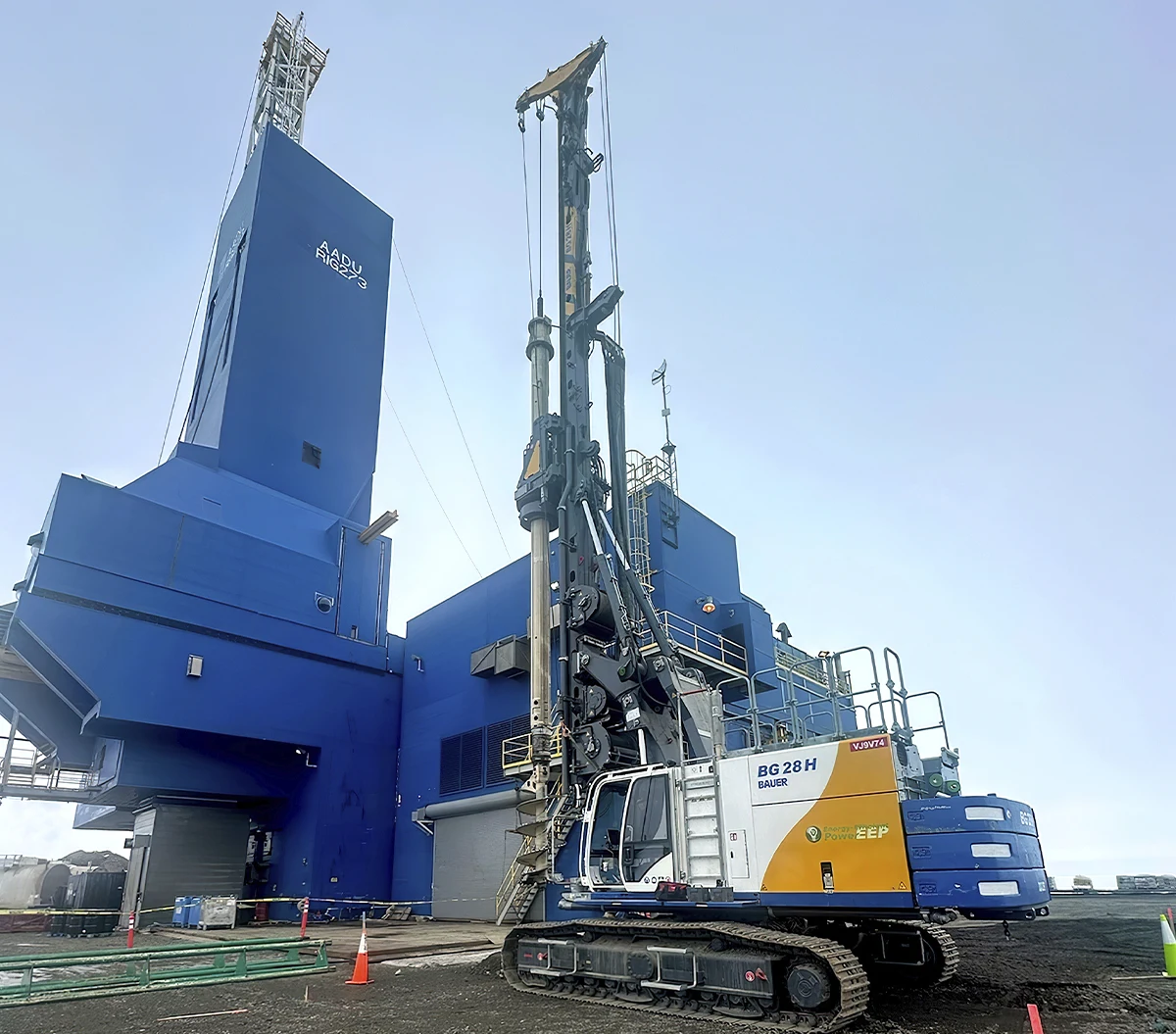
“We do a lot of projects that are very remote, challenging projects,” DePeter adds. “That’s kind of what has set us apart.”
Torsten Mayrberger, an engineer and vice president of Associated General Contractors, or AGC, of Alaska member company PND Engineers, has worked on numerous projects with Onyx Drilling. He says the company is his first choice.
“If it’s anything to do with drilling holes in the ground or installing piles, they’re absolutely my go-to,” he says. “After so many years, I can’t imagine doing some of the more out-of-bounds stuff without Tom.”
Mayrberger cites a cone penetration testing, or CPT, sampling project the duo conducted from a sheet of floating ice in April 2024 as one of their more “out there” projects.
“It was something new that we did here in Alaska,” he says. “We both like a challenge and are kind of allergic to bread-and-butter jobs. The crazier the project seems, the more interesting it becomes to both of us.”

“We’re small and very diverse, so we kind of pick and choose our projects,” DePeter says. “There are quite a few that we pass on. If I had my way, I’d do every job that came across the desk, but that’s not the case.”
What makes Onyx Drilling’s full workload even more impressive is that it has zero social media presence and is only just now creating a website—“We’re definitely behind the times on all of that,” DePeter says—which means the company relies heavily on word-of-mouth referrals and networking. That’s what makes membership in the AGC of Alaska worth its weight in gold.
“I think the most beneficial thing of being involved in the AGC is just their networking system and getting our name out,” he says. “Going down to Anchorage annually and chatting with all the folks that go there I’d say is the most beneficial thing for us.”
That, and giving clients nothing but positives to share about their work.
“I’m sure everybody strives to give their best, but I think that’s our thing,” Eddy says. “We want to get in and get out and make it perfect every time.”
“We definitely strive for perfection with every job we do,” DePeter agrees. “That’s kind of our motto: ‘Perfect is adequate.’”


ore than twenty Associated General Contractors, or AGC, of Alaska members and staff made their voices heard in Juneau during the Legislative Fly-In, held February 25 and 26. It’s an annual event that helps AGC educate legislators about the importance of the construction industry to Alaska and discuss issues of concern with state staff and department heads. AGC of Alaska joined with the Alaska Miners Association and Alaska Trucking Association to host a reception at the Baranof Hotel February 25 that was well-attended by members of the hosting organizations and legislators.
Through the two-day fly-in, members met with nearly thirty state legislators and commissioners. Department of Labor Commissioner Cathy Muñoz spoke with AGC members at a luncheon, updating them on industry-related topics her department was working on. AGC members also participated in a four-hour meeting with Alaska Department of Transportation and Public Facilities staff, along with follow-up meetings with department officials throughout the week.
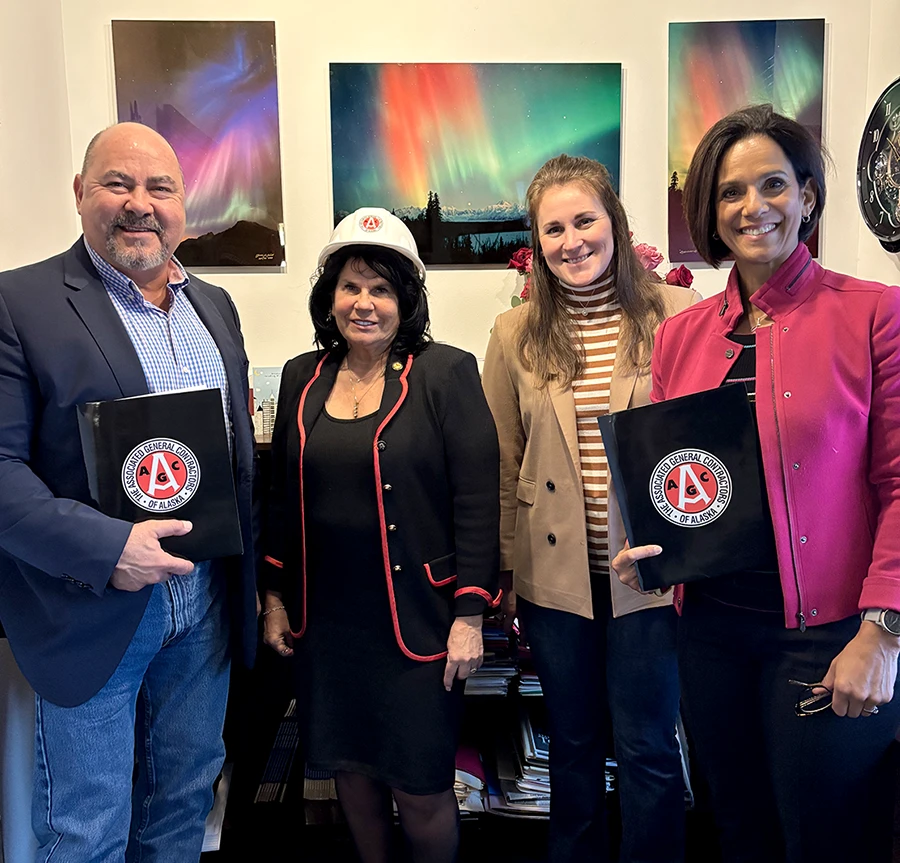
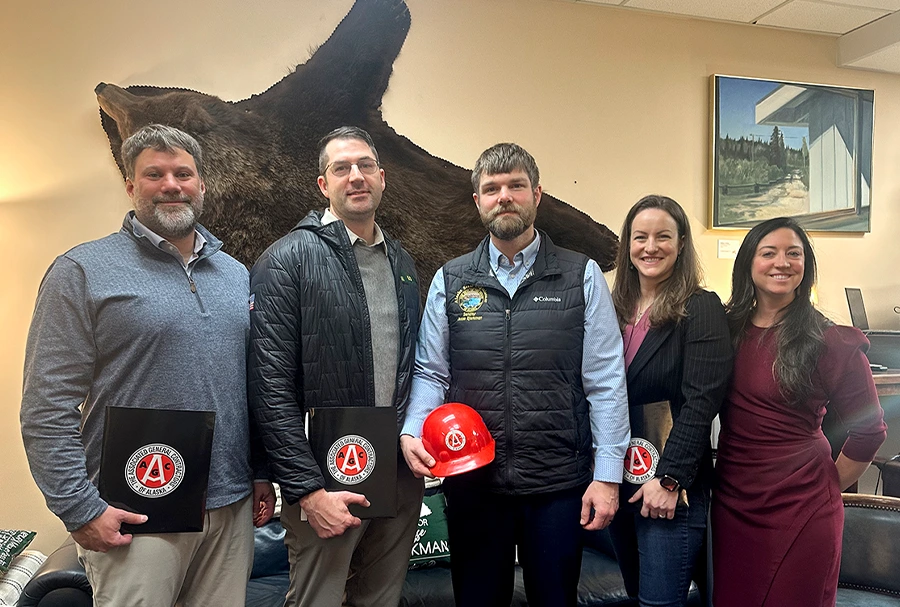
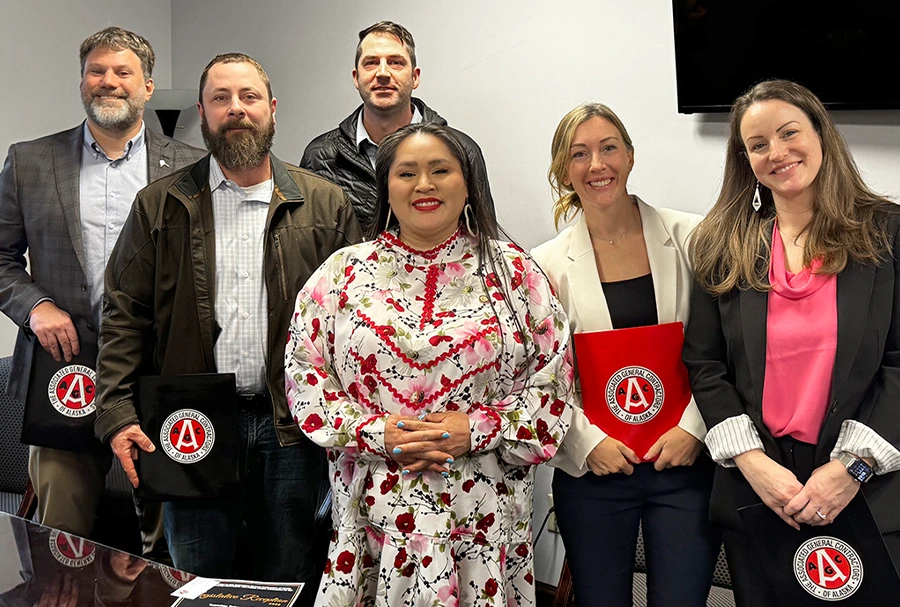
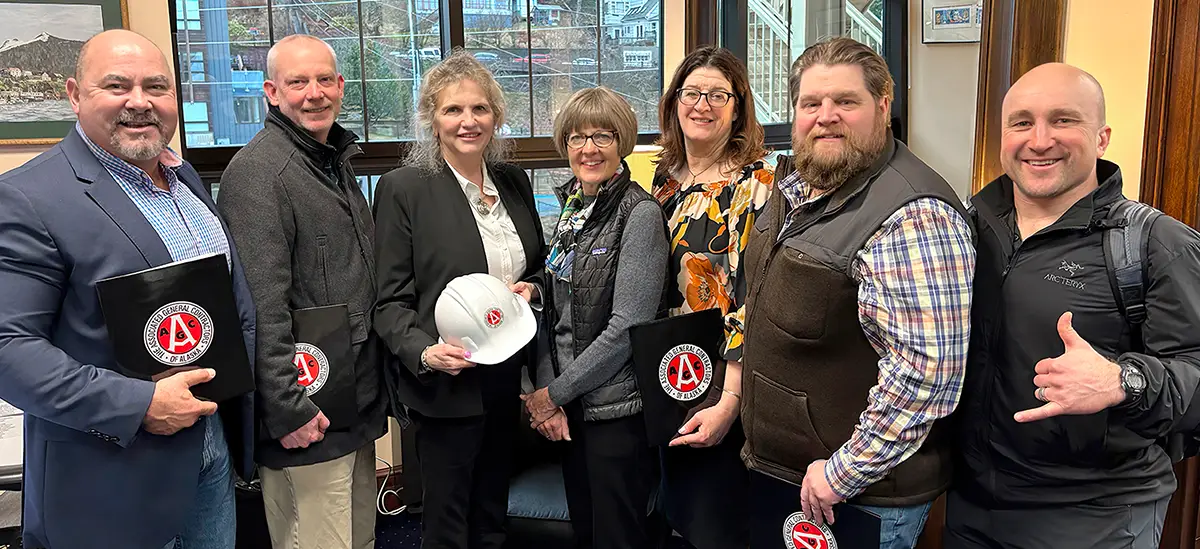
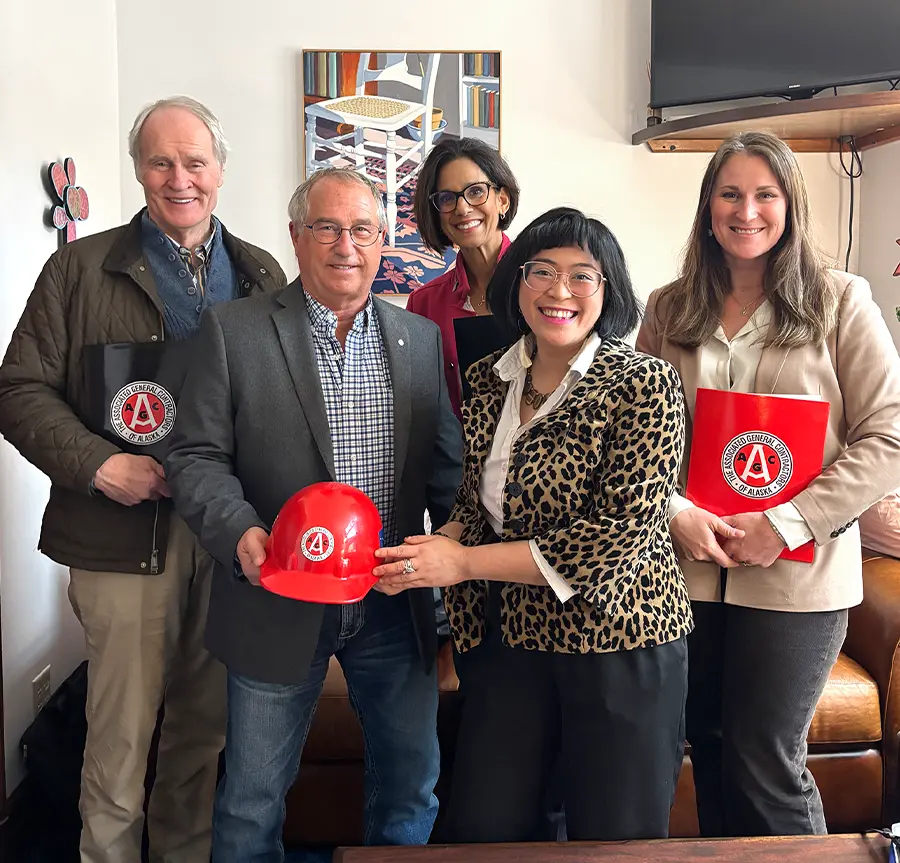


he 34th Alaska State Legislature adjourned its 2025 session a day early, gaveling out on May 20. The House and Senate garnered enough votes to override Governor Mike Dunleavy’s veto of the education funding bill, House Bill, or HB, 57, that includes some policy measures and an approximate $700 increase to the Base Student Allocation. At the time of this article, it was yet to be seen whether the Governor would line-item veto the associated appropriation.
While lawmakers met their constitutional duty to pass a balanced budget, they failed to secure the three-quarters majority vote needed to fund the fiscal year 2025, or FY25, supplemental budget of $193 million using the Constitutional Budget Reserve, or CBR, one of the state’s main savings accounts.
Without the ability to use the CBR, funding FY25 expenses defaults to contingency language added by the House and Senate Conference Committee to use up to $100 million from the unrestricted balance of the Alaska Industrial Development and Export Authority, or AIDEA. Any remaining deficit above $100 million would come from the Higher Education Investment Fund, or HEIF—not an ideal fix, as this could have a significant negative impact on AIDEA’s bonding rate.
The capital budget also remained austere, with the notable absence of district priority projects. But it did include funds for deferred maintenance and statewide emergency response. Some highlights:
- $1,000 PFD
- $700 increase to BSA
- Increases to childcare grants and behavioral health support
- Additional funding for Village Public Safety Officers and funding of State Trooper overtime hours
- $36 million in deferred maintenance for schools, university facilities, and statewide emergency repairs
- Alaska Marine Highway vessel maintenance, using $26 million in fare revenue
- Dalton Highway, or Haul Road, maintenance
- Port electrification for cruise terminals
Key legislative efforts this session included Associated General Contractors, or AGC, of Alaska’s invitation to testify before the Senate Transportation Committee on the importance of a robust, timely, and accurate Statewide Transportation Improvement Plan, or STIP. AGC Executive Director Alicia Amberg, along with industry representatives, shared concerns regarding the lack of available projects for this summer’s construction season. Additionally, AGC, in partnership with the American Council of Engineering of Alaska, provided the state Department of Transportation & Public Facilities, or DOT&PF, and legislators with an industry white paper defining key metrics for a successful DOT&PF program, year over year.
AGC engaged in advocacy efforts on numerous bills, including HB 161, pertaining to paid sick leave exemption, which would exempt employers with fewer than fifty staff members from the state’s new sick-leave requirements, implemented via Ballot Measure 1, which passed in 2024.
AGC supported HB 148/Senate Bill 132, pertaining to controlled insurance programs, and provisions in HB 133, supporting prompt payment to prime contractors. We voiced concern over HB Bill 186, which requires a percentage of workers on state projects to be in a registered apprenticeship program, and were successful in our efforts to encourage legislators to not approve this bill as written.
AGC’s Legislative Affairs Committee, or LAC, held weekly meetings where bills were continually monitored and reviewed to determine support, opposition, or neutrality. AGC voiced support for bills that would have positively enhanced our industry and discouraged movement or provided alternative solutions on several bills that could have negatively impacted our industry. The LAC laid the groundwork to continue our work on these bills in the next session.
LAC members organized a well-attended fly-in event to the state capitol in February, with more than twenty participants—the most to date! This year’s fly-in looked a little different than in past years, with the primary focus being on advocating for a robust DOT&PF program. AGC members met with key legislators and policymakers to voice concerns contractors faced as they geared up for a less-than-robust summer construction season. AGC’s concerns resonated throughout the Legislature; we will continue to dialogue with elected officials and DOT&PF staff to discuss ways to ensure DOT&PF’s annual construction program is sustainable for industry given the state and federal budget climates.
The fly-in event, along with the continued work of the LAC, plays a crucial role in advancing industry priorities, shaping policy outcomes, and championing a supportive business climate for the construction industry.



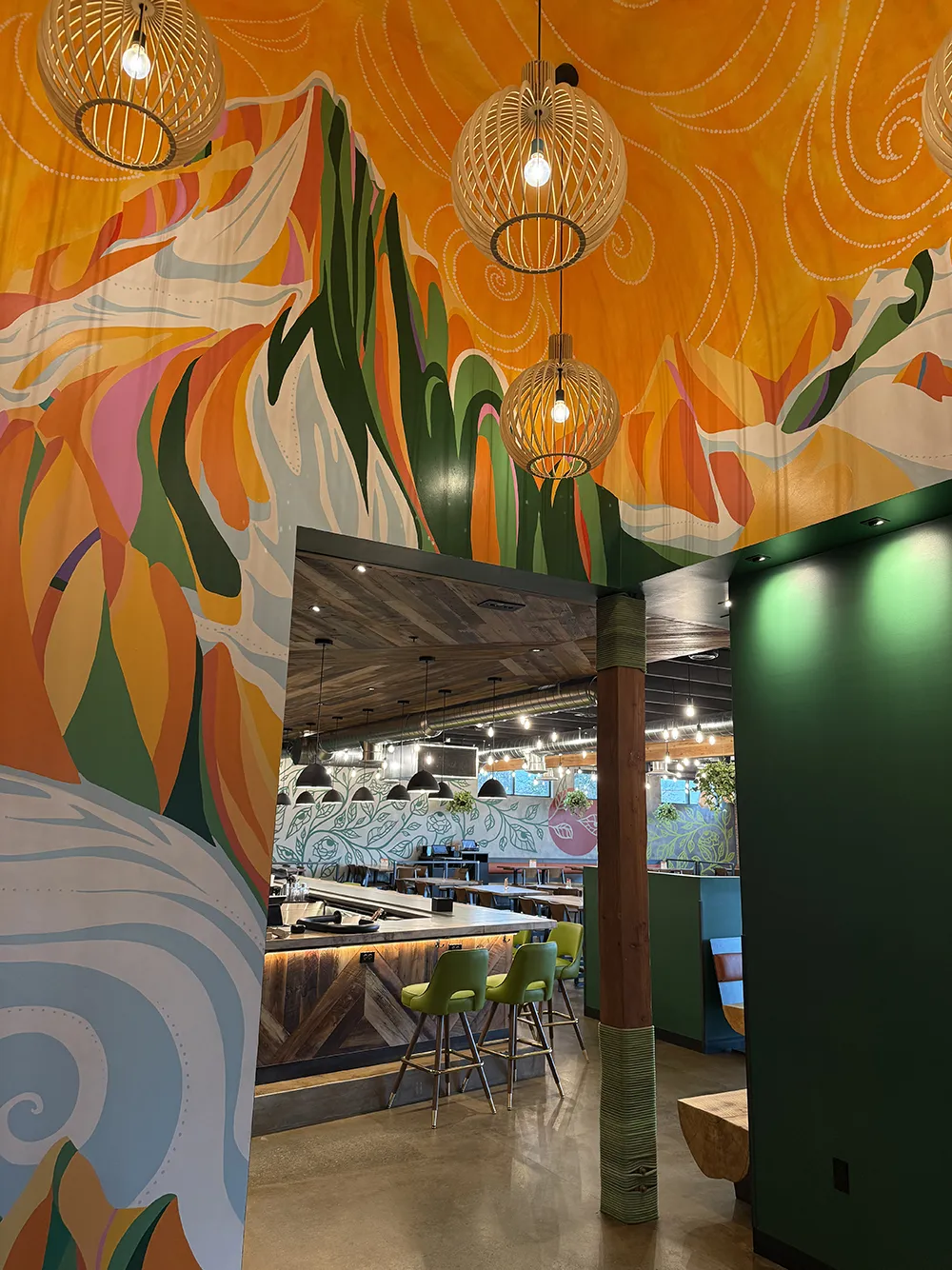
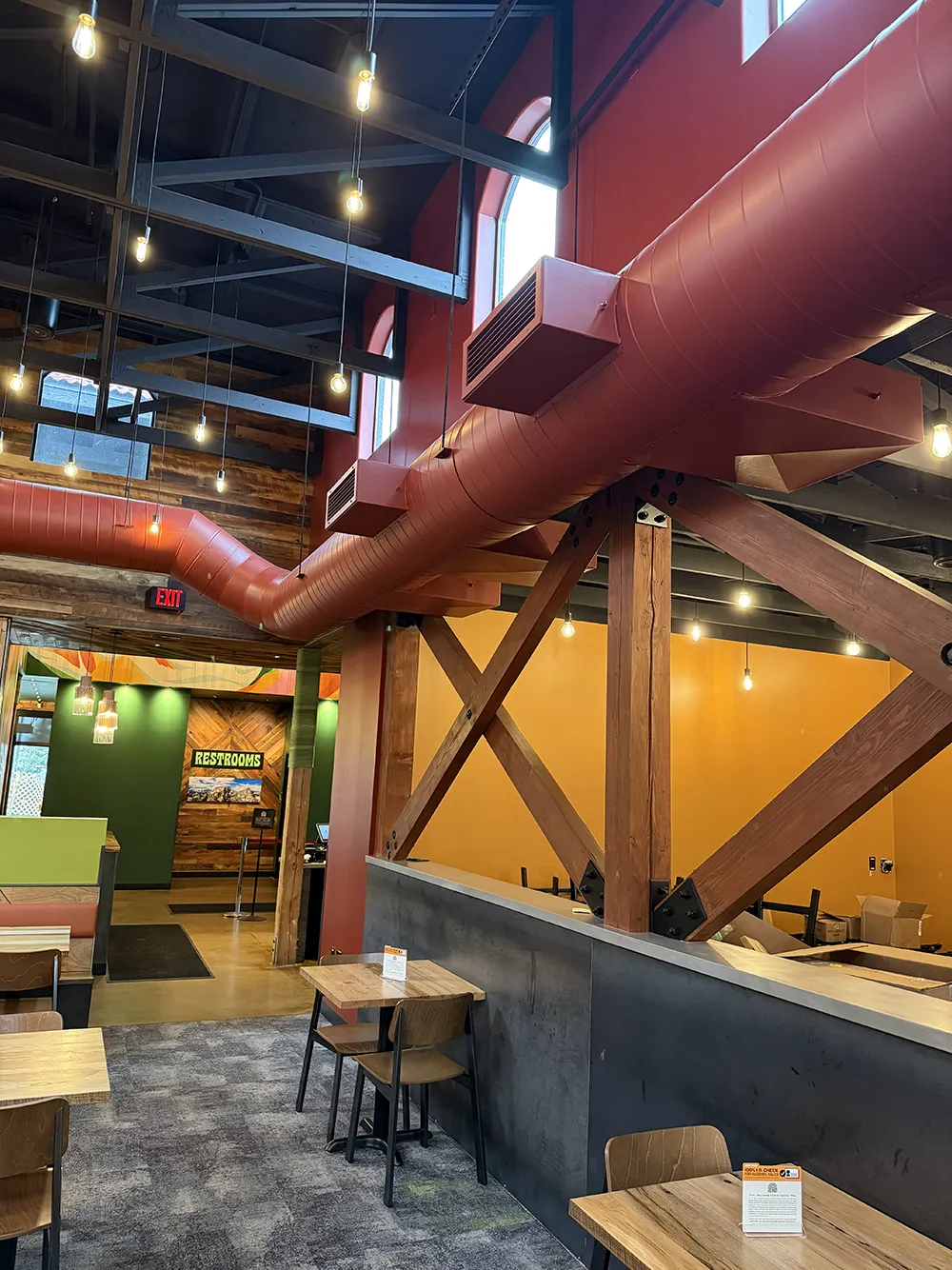

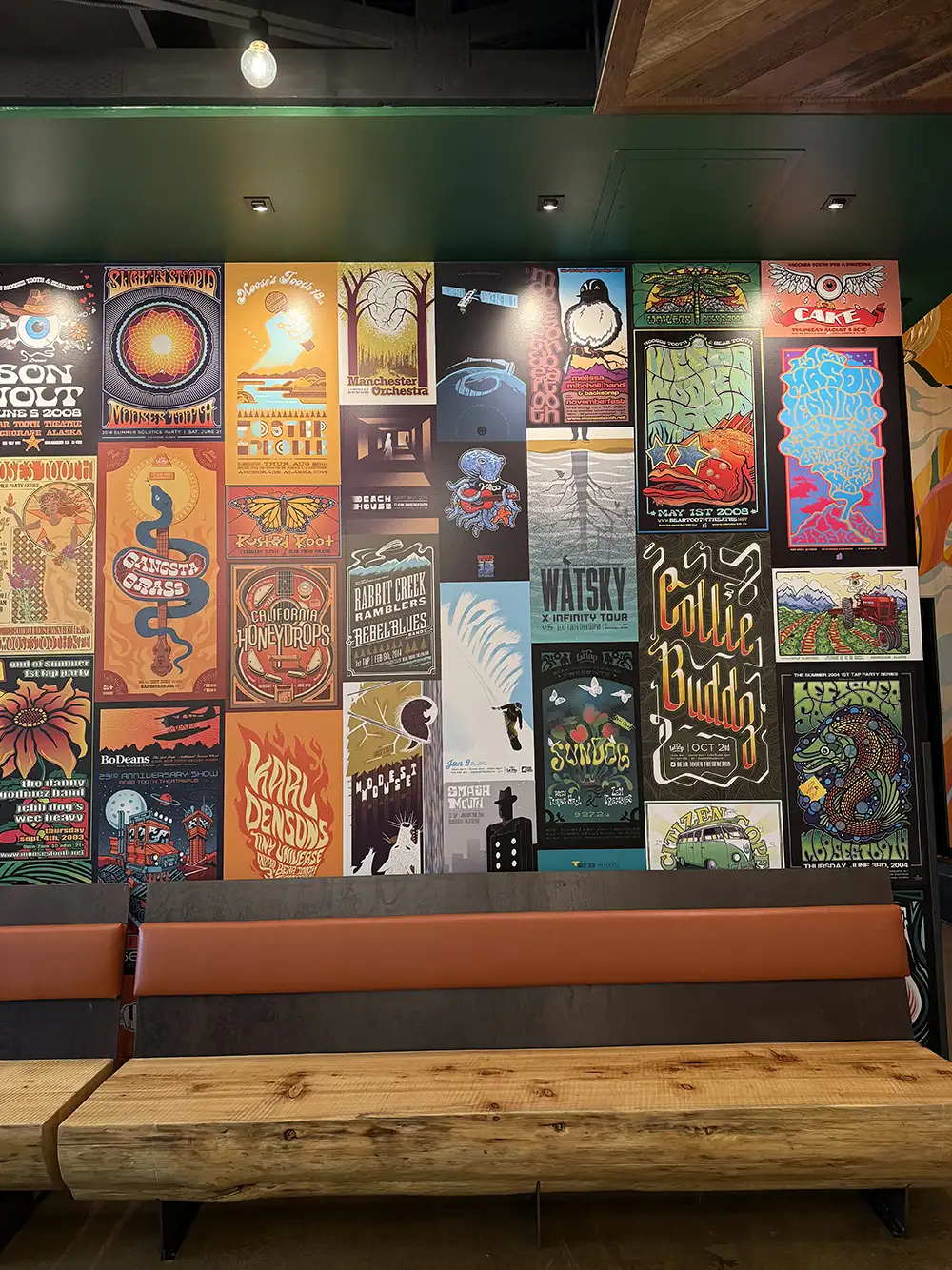
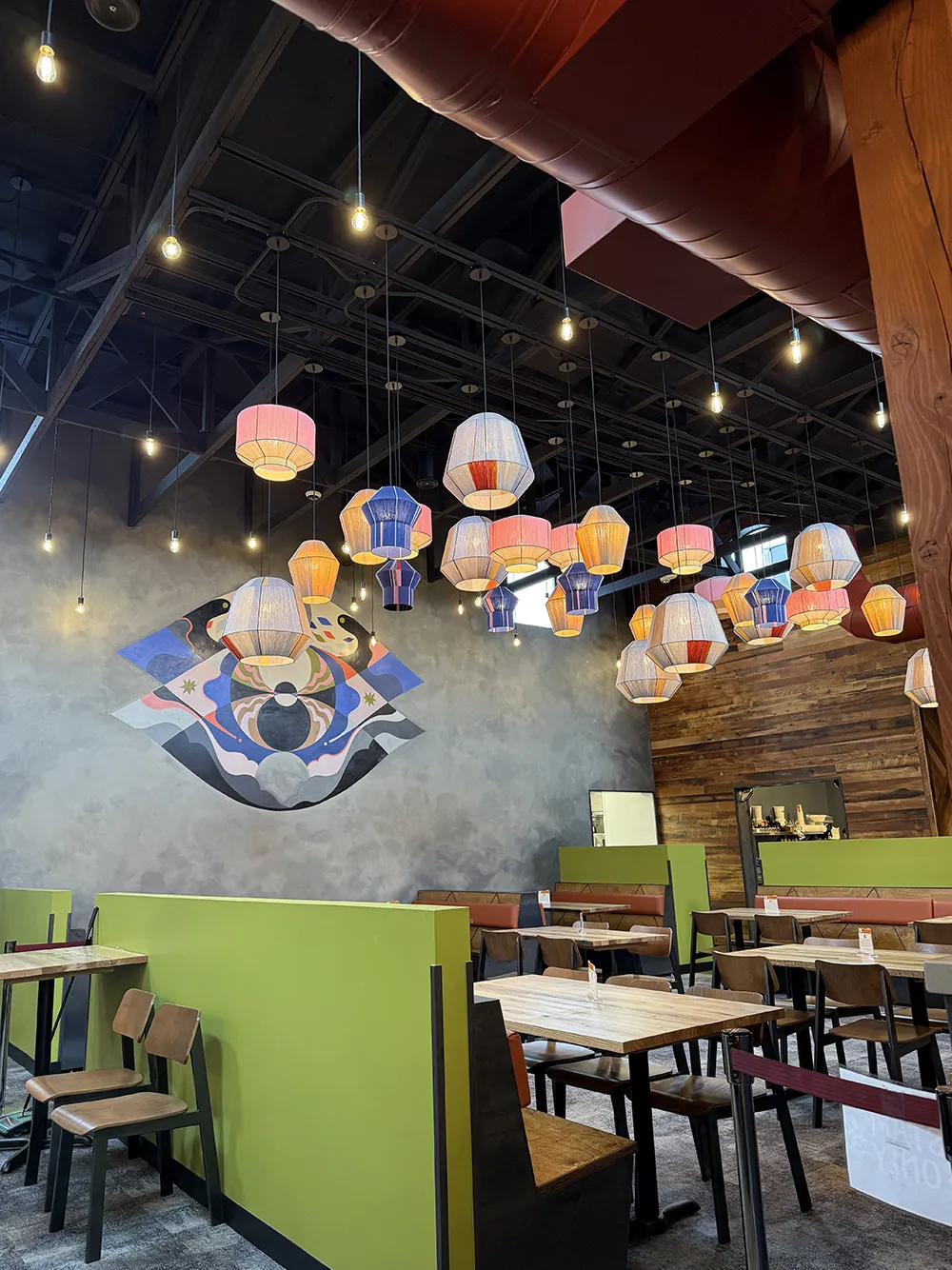
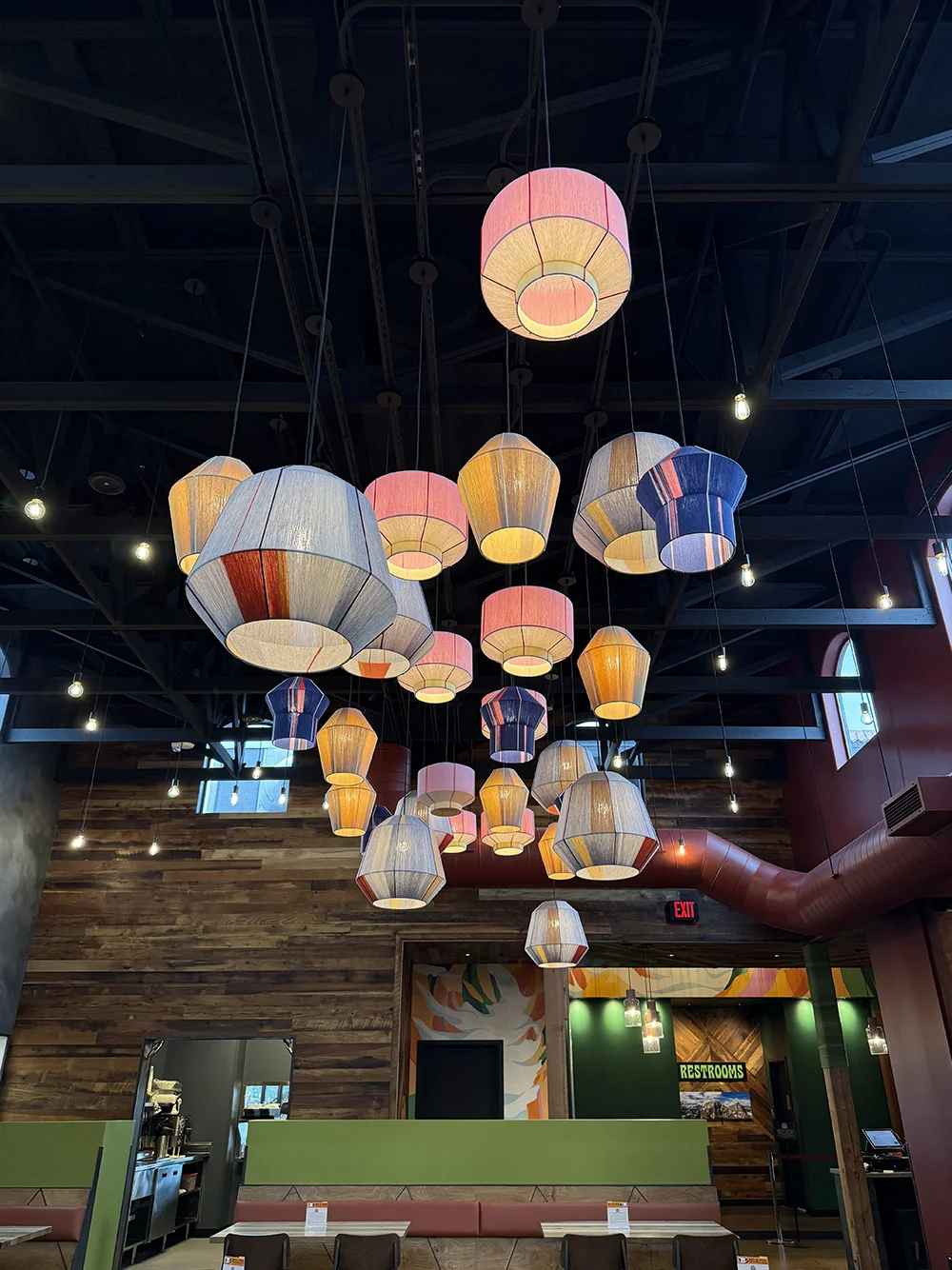
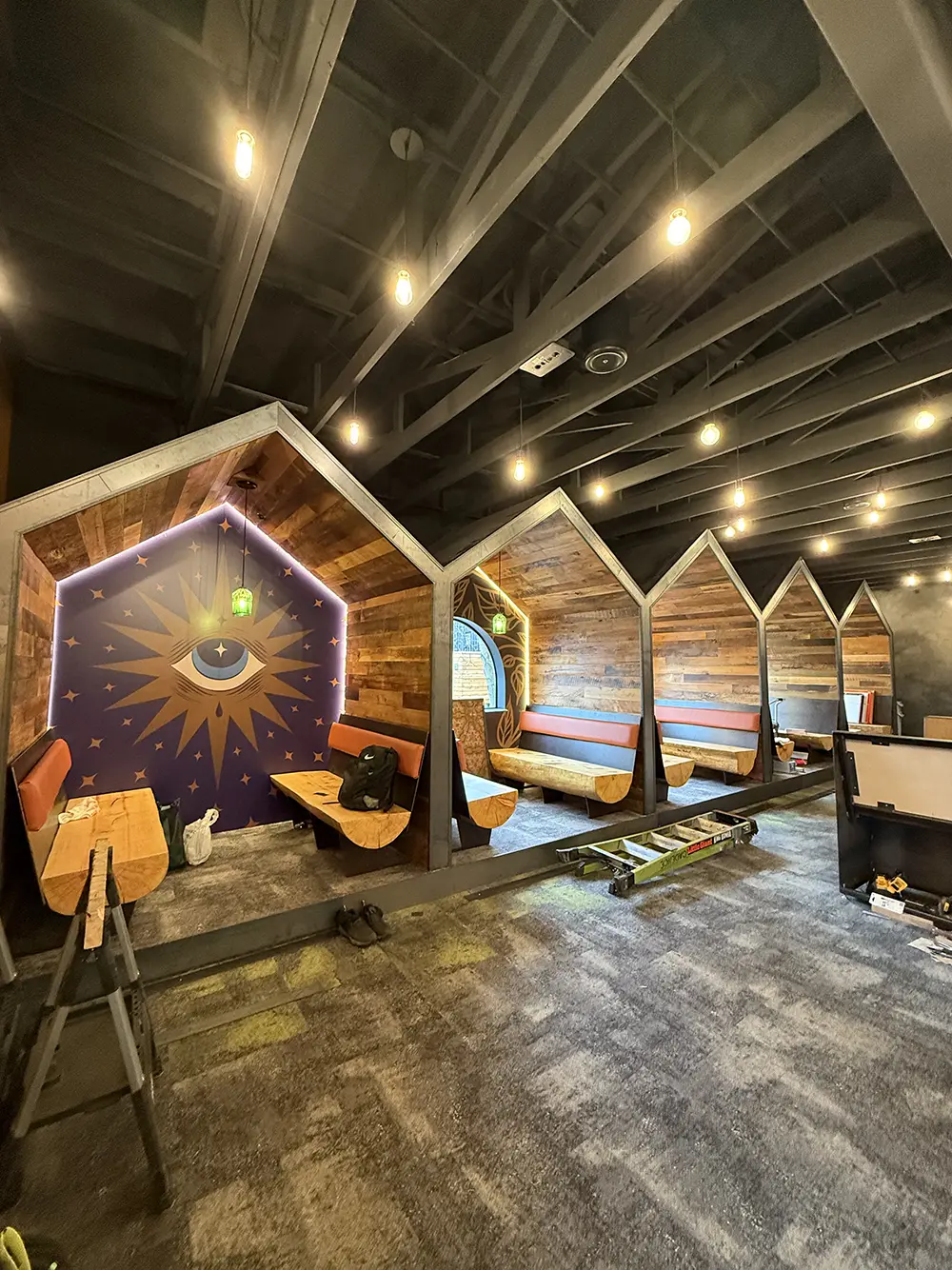


Eye Tooth Tavern & Eatery
Contractor
Cadence General
Jon James
Project Manager
Kendall Wilson
Cadence General

AGC Member Since 12/16/2021

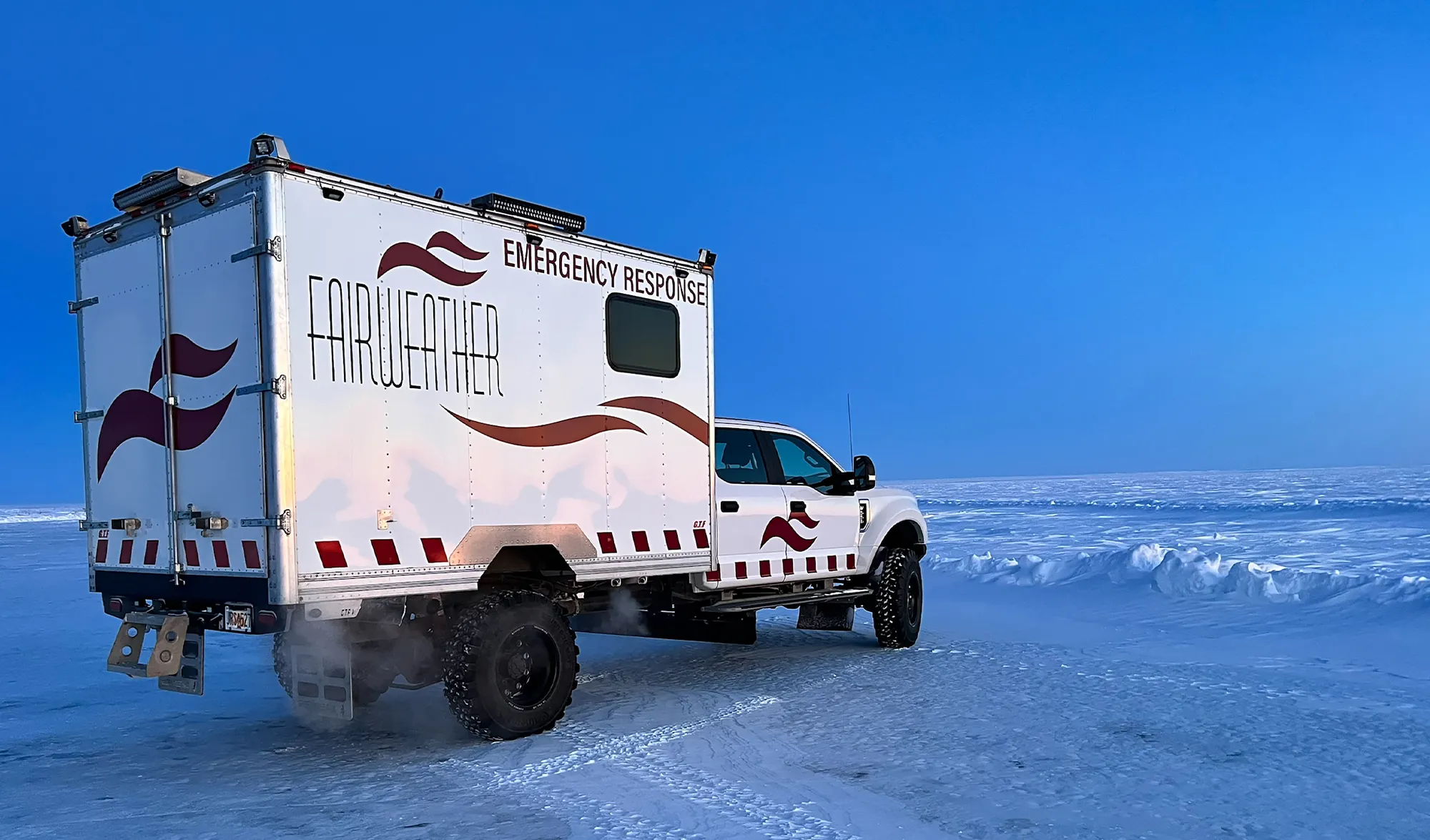
hen embarking on industrial jobs in remote regions of Alaska, companies face a multitude of challenges: preplanning, engineering, logistics, operations, aviation safety, medical care, and weather forecasting, for example. That’s where Fairweather LLC comes in, with its large staff of professionals to supply expertise.
“It depends on what the client needs,” Fairweather President and General Manager Rick Fox says, summarizing the company’s range of services.
For nearly half a century, Fairweather has been handling details that allow businesses to bring their visions to fruition.
“We fill in all the gaps where they need help,” Fox explains. “We’re supporting our clients to reach their goals.”
Founded in 1976 by Sherron Peary, a friend of Fox’s since high school, the company began by providing aviation-related weather forecasting at remote drilling locations. From there, Fairweather quickly expanded into other arenas, including runway certifications, coordinating materials deliveries, engineering, and—crucially—supplying rigs and other worksites with trained medical professionals able to provide routine and emergency care in places where clinics and hospitals might be hours away.
President and General Manager,
Fairweather LLC

A Fairweather employee on site in Black Rock City—the temporary city that springs up around Nevada’s Burning Man celebration—installing a temporary remote runway, complete with a Fairweather windsock.
During the ‘90s, Fox relocated to Louisiana, but when Shell purchased some leases in Alaska in 2005, “they asked me to come back up, open the office, and get started.” Five years later, Fox retired and was asked to join Fairweather. “Eventually I became a half owner of the company.”
Much of Fairweather’s work continues to revolve around drilling, he says. “We typically do operational forecasting, like sea and ice conditions for offshore, and weather for onshore.
“Aviation support is another big piece,” Fox adds, explaining that Fairweather provides “forecasts for planes before they try to approach an airport.”
They do a lot more as well, he continues. “We support the industry in every way. Everything from project management to drilling engineering, completion engineering, logistics, and civil engineering. Most of our teams are set up to do projects or drilling programs.”
Smaller companies that can’t afford the resources to do the services-related jobs themselves comprise a sizable portion of Fairweather’s client base, Fox notes. “This is a big deal and they need a lot of help. We want to get it done right for them.”
One of those companies is Alaska-owned Furie Operating Alaska. “We’ve got people involved with [Furie] in different areas, and we’re glad for their success,” Fox says.
Furie president and CEO John Hendrix values his company’s partnership with Fairweather, calling it “a local company that has survived and thrived since 1976. They have great people with great depth in the sciences and engineering that I would highly recommend. Fairweather is currently managing and supporting our offshore Cook Inlet drilling program. The project is currently on schedule to deliver much needed natural gas for Alaskans in July.”
In Alaska’s famously unpredictable economy, Fox says the key to Fairweather’s longevity has been its ability to quickly adapt to new circumstances. “We look at what work is out there and we figure out how we can adjust our plan to take on what the clients need. We’ve seen times when exploration was very slow and other times when they were stacked on top of each other and we could hardly get all the work done.”
The pandemic brought entirely new and unprecedented challenges as worksites simply shut down. But thanks to its medical staff and experience, Fairweather won a federal contract running vaccination clinics across the state. “We did a lot of things to support our community and keep our people employed during COVID,” Fox says.
Doyon, Limited recently acquired 90 percent of Fairweather, which currently has about 360 employees.
“They’re a great Alaska company to work with, they bring strengths to the table that we didn’t have before,” Fox says of Doyon, adding that the future looks rosy for Fairweather and for Alaska. “It’s a very exciting time. I expect over the next couple of years, we’ll see more and more activity.”

n the heart of Prince William Sound, the remote village of Chenega stands out as a place known for its stunning beauty, enduring resilience, and persistent challenges. Accessible only by air or water, this isolated community dreamed of reaching a major milestone in its efforts to accommodate the people who play a vital role in its sustainability. With the completion of the Chenega Multipurpose Housing Facility, the community’s vision is now a reality.
Led by F&W Construction Company, Inc. and guided closely by Chenega Regional Development Group, LLC, the $6 million design-build project is a direct response to the community’s severe housing shortages that came into focus during the COVID-19 pandemic. But its purpose will go well beyond pandemic recovery.
The facility will serve as a home away from home for visiting teachers, healthcare professionals, emergency responders, and construction workers who are essential to the region’s continued growth.
“Chenega has long faced a shortage of housing to accommodate essential personnel who come to support the community,” says Doug Lipinski, project manager for Chenega Regional Development Group. “This project marks the most significant expansion of housing in Chenega since the community resettled on Evans Island in 1984, following the devastating impact of the 1964 Good Friday earthquake and tsunami on the original village site on Chenega Island.”

With walls up and windows installed, the Chenega Multipurpose Housing Facility nears completion in its remote coastal setting.
Urgent and Lasting Needs
The new facility provides the infrastructure to support visiting professionals and frees up housing within the village, allowing for more long-term residential growth, says Lipinski. It represents a turning point in Chenega’s post-resettlement development and provides critical flexibility for hosting educational, medical, and infrastructure teams.
The building is designed with flexibility and functionality in mind, Lipinski says, featuring six separate living units and a shared common area that can be used as a meeting or gathering space. The layout includes two efficiency units, two two-bedroom units, and two three-bedroom units.
Each space is equipped with a full kitchen, providing comfort and independence for short- and long-term guests. In total, the facility can house up to twelve people.
Chenega Regional Development Group selected the site for the facility to capitalize on the stunning views of Crab Bay, located in southwestern Prince William Sound—west of long, narrow Montague Island and east of Seward. This intentional design decision not only enhances the quality of life for those staying in the units but also highlights the natural beauty that defines Chenega, says Lipinski.
Though the building was not yet ready for occupancy in early May, the community already began to respond positively.
“People like the layout of the units and the views,” says Lipinski, noting that initial walkthroughs have generated enthusiasm about the thoughtful design and comfort of the facility, which opened in June.
“We had to ensure constant delivery of food and materials to the site—something that’s incredibly difficult in winter,” says Saigen Harris, project manager for F&W Construction and Associated General Contractors, or AGC, of Alaska president. “There were two different periods where we couldn’t get materials or food for over two weeks. But because of our planning and forecasting, there were no safety issues or schedule impacts.”
Anchorage-based F&W has more than six decades of experience delivering infrastructure in Alaska’s most challenging environments. A third-generation, family-owned firm, F&W has built its reputation on integrity, safety, and innovation. Its teams are skilled in a variety of construction disciplines, from structural steel and modular construction to timber framing and pre-engineered buildings.
The company has a deep understanding of rural Alaska’s seasonal and logistical challenges, says Harris. F&W’s crews are highly experienced in transporting materials by barge, plane, and helicopter to isolated job sites. The team’s logistical planning and field expertise helped ensure this project was equipped with the right people, tools, and materials to succeed safely and efficiently.
Project Manager, F&W Construction Company, Inc.

A fully equipped kitchen in one of the units of the new Chenega Multipurpose Housing Facility is ready for use.
More than a Building
Local input played a crucial role in shaping the project. Village-based Chenega staff shared institutional knowledge that informed key decisions—from landing sites for materials to site preparations for winter.
“Their involvement helped ensure that this project was grounded in local realities and responsive to the village’s needs,” says Lipinski.
A collaborative network of highly skilled subcontractors and consultants ensured the success of the Chenega Multipurpose Housing Facility. AK Underground’s civil work enabled rapid mobilization, expediting the construction schedule. Samson Electric and Slayden Plumbing & Heating Inc. also played major roles, providing in-depth design reviews that prevented change orders later in the process. AGC member companies working on the project included project architect KPB Architects; Malone Construction LLC, which performed concrete placement and finishing; and roof installer Rain Proof Roofing.
Their early participation in the design phase allowed F&W to spot potential issues long before they impacted the job site, says Harris. That kind of foresight is what made the difference in sticking to the schedule and avoiding costly changes.
While the Chenega Multipurpose Housing Facility may be a single structure, its impacts are broad and deeply felt. Overall, it strengthens the community’s infrastructure, honors local knowledge, and provides a much-needed lifeline to those who come to support the village.
And as Chenega continues to grow and rebuild in the wake of its relocation, Lipinski says this project represents progress and possibility, proving that, even in the most remote corners of Alaska, development rooted in responsiveness and respect can be successful.


etting the year started in style, Associated General Contractors, or AGC, of Alaska members met Thursday, May 1, at the Westmark Hotel in Fairbanks for a Spring Kick-Off party ahead of an all-day Friday agenda filled with presentations from the Alaska Department of Transportation & Public Facilities, Alaska Gasline Development Corporation, the Alaska Industrial Development and Export Authority, the Alaska Railroad, UAF, Fairbanks-North Star Borough, and City of Fairbanks. Around 150 people attended the Agency Day talks, including the highly-attended lunch presentation by Davis, Wright, Tremaine LLP discussing how to avoid pitfalls when implementing Ballot Measure 1, pertaining to sick leave.
The Thursday reception included a meet-and-greet for prime contractors and Interior-based disadvantaged business enterprises, or DBEs. Some state contracts, particularly for projects within the Alaska Department of Transportation and Public Facilities, have requirements regarding hiring DBE-certified companies; the meet-and-greet provided an opportunity for networking.
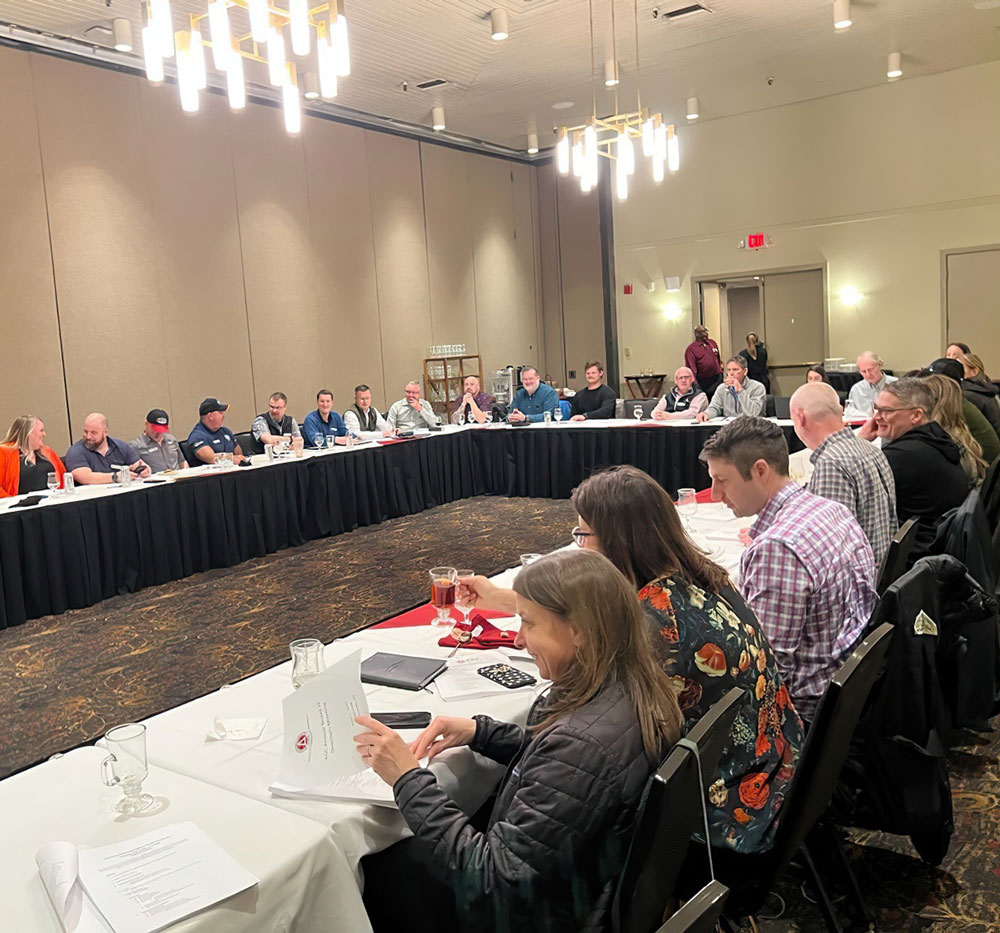


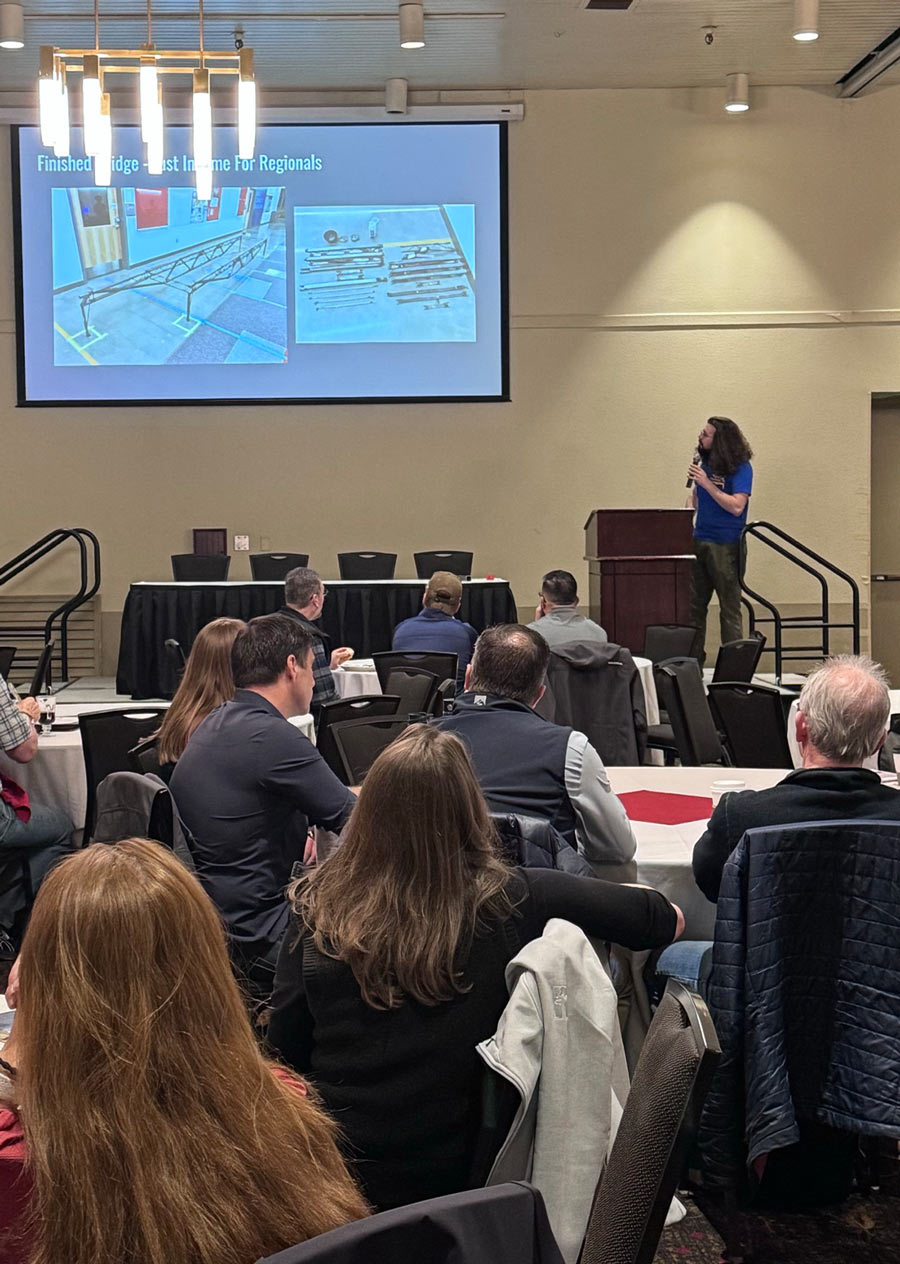
AGC of Alaska would like to thank the Spring Kick-Off and Agency Day sponsors for making the event a success:
- STG Pacific, LLC
- Yukon Equipment, Inc.
- Brice Pacific, LLC
- Great Northwest Inc.
- Brice, Inc.
- Equipment Source, Inc.
- Loken Construction LLC
- Meridian Management Inc.
- Shannon & Wilson, Inc.
- TOTE Maritime Alaska, Inc.
- Alaska Powercom Supply
- Denali Industrial Supply
- F & W Construction Co., Inc.
- Granite Construction Company
- Hale & Associates, Inc.
- Loken Crane, Rigging & Transport, LLC
- North Star Equipment Services
- Olson Creek, LLC
- PFK Enterprises, Inc.
- TDL Staffing

Victaulic Company

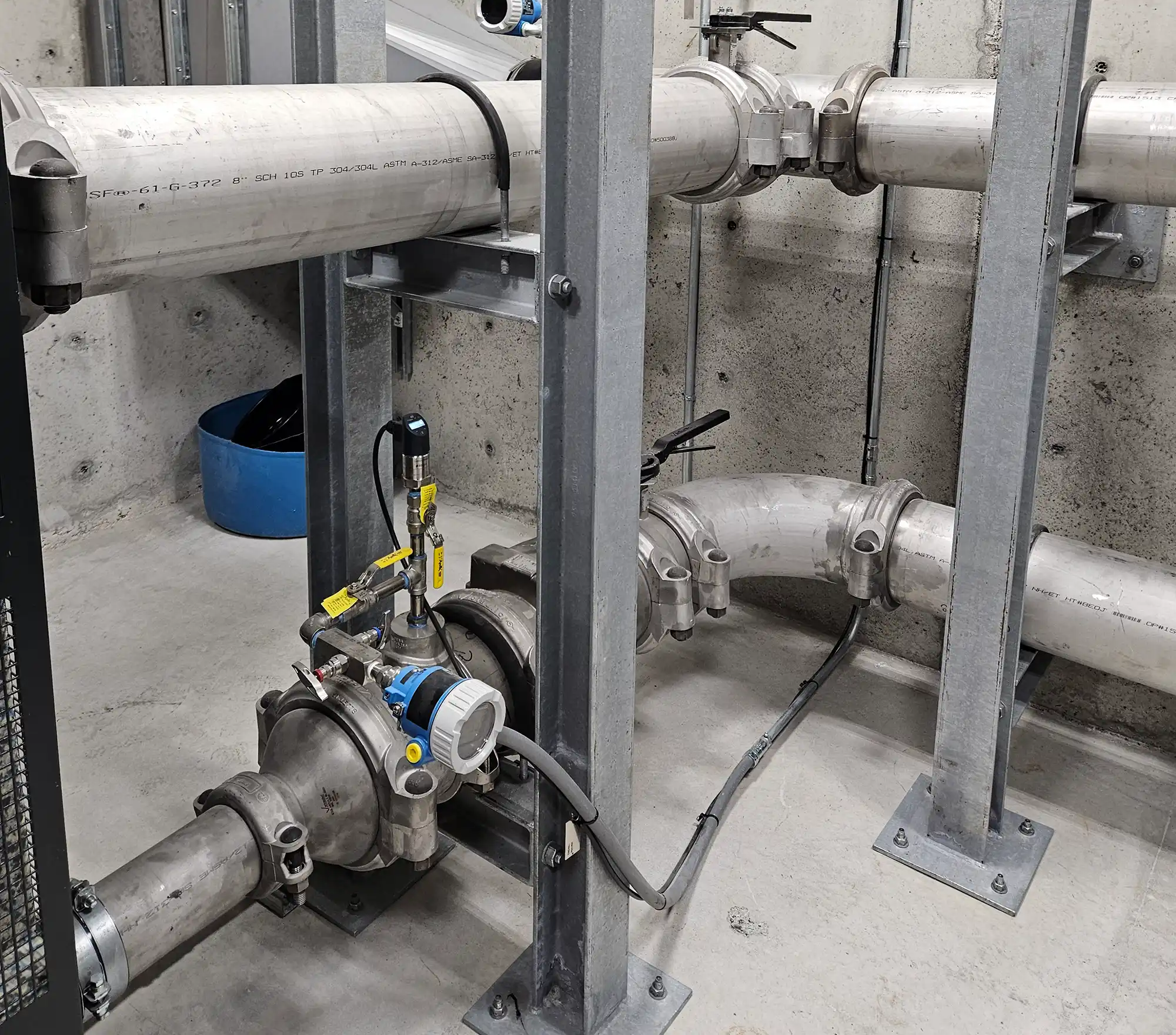
ictaulic has experienced every kind of economic cycle, market shift, and industry trend imaginable since it created its first pipe coupling in 1919. Its founder, Ernest Tribe, built the concept of resilience into the company name, a combination of the words “victory” and “hydraulic.” After 106 years in the business, Victaulic continues to innovate the pipe-joining technology used in structures worldwide.
Alaska Territory Manager Derek Bradish says Victaulic completed several water treatment projects in Alaska in 2024. The company outfitted plants in Wrangell and Bethel with Victaulic coupling systems and provided mechanical services to a at Joint Base Elmendorf-Richardson. He says it was a particularly busy year, filled with many similar projects—which is sometimes challenging, as he is the only Victaulic manufacturing sales representative in the state.
“When you’re the only one here, time management is the biggest challenge,” says Bradish. “I wear a lot of different hats and work with people in many different industries.”
Bradish says his position also requires him to become an expert in multiple industries. For instance, the products and systems needed for a wastewater plant are different than what is necessary for an oil and gas power plant or a mine. The only way to fully assist these different industries is by becoming well-versed in their specific needs.
Since its official inception in 1925, Victaulic has created pipe-joining solutions to meet these needs. Its initial grooved, malleable iron fittings quickly became the standard worldwide for oil, gas, water, sewage, and air pipelines, as well as water and air lines for mines. Later, Victaulic adapted its products to plumbing, heating, and air-conditioning systems. As the construction industry continued to boom, Victaulic increased its focus on product development, which led to the innovation of valves, flange adaptors, and mechanical tees.
Innovation in products and services is nonstop, says Bradish. Over the past two years, he says, Victaulic has developed new valves and gaskets better suited for specific types of media in the pipe. For instance, the company offers a new gasket that can handle the various chemicals used to treat and disinfect water. Bradish says that many states use a different combination of chemicals to make water safe for human consumption, so it made sense to develop a gasket that could withstand multiple processes.
“In this day and age, we are constantly innovating materials and technology,” says Bradish. “Our new couplings and gaskets are better than the last ones, and we didn’t come out with those all that long ago.”

Last year, Victaulic worked with Mantech Mechanical to outfit the water treatment plant in Wrangell with a new coupling system. Victaulic completed several other similar coupling projects statewide in 2024.
Joint Efforts and Connections
“It’s a long process,” says Bradish. “These jobs have a lifespan of two or three years, and you start working now, so they come to fruition four or five years down the road.”
Victaulic has played a vital role in numerous projects statewide. Noah Velasquez, chief operations officer for Inlet Mechanical, says the recently renovated Bethel Water Treatment Plant features various types of plastic, copper, and steel Victaulic systems. Inlet Mechanical first worked with Victaulic about five years ago, when their products were listed in the job specification. Since then, the two companies have built a strong relationship.
“They are very helpful with making sure they can provide you with what you need,” says Velasquez. “They have the knowledge and skills to install their products and offer services that meet the scope of the project.”
Victaulic has been an Associated General Contractors, or AGC, of Alaska member since May 2015. Bradish says networking is the main AGC benefit his company appreciates. There are so many great people in Alaska, and the ability to connect with contractors and develop genuine friendships and solid working relationships is valuable, he says. AGC offers many fun events that allow members to get to know each other and celebrate hard work, he adds.

oint Base Elmendorf-Richardson, or JBER, is slated for another round of extensive military construction in 2025. As crews continue work on JBER’s north-south 16/34 runway extension, the US Army Corps of Engineers–Alaska District, or USACE, is close to selecting a contractor for a new state-of-the-art Joint Integrated Test and Training Center, or JITTC. These projects, and several others statewide, are part of a larger national defense strategy to increase operational readiness, safety, and security.
Alaska’s proximity to both Asia and the Pacific makes it an ideal launching point for homeland protection. Alaska is considered a critical component to the nation’s ballistic missile defense system, and military bases here will serve an expanding role of protection as companies explore arctic shipping lanes that, due to decreasing sea ice, are increasingly open for travel.
To prepare forces for the new challenges, the US Department of Defense, or DOD, is investing up to $500 million to develop a facility at JBER that will increase the responsiveness of agile combat warfighters and support teams.
The JITTC construction project includes a 150,000-square-foot technologically advanced facility that will house the joint-simulated-environment, or JSE, training platform; simulator rooms; briefing rooms; mission operations centers; a central server room; an auditorium; administrative space; a security office; break rooms; and storage. Crews will also build supporting infrastructure for the facility, such as a utility yard for chiller equipment, standby generator enclosures, fuel tank areas, and a 15 MVA substation. The project will include additional site improvements such as earthwork, landscaping, exterior lighting, parking, sidewalks, and roads.
JITTC will be built to withstand cold weather conditions, with a reinforced concrete foundation, a structural steel frame, insulated steel panels, masonry walls, and a standing seam metal-and-membrane roof. Inside the facility, crews will build a raised-access floor system and partitions, along with electrical, plumbing, environmental, and communication systems. All systems are designed for sustainability, including energy efficiencies that meet high-performance principles. Likewise, secured spaces will follow standards outlined in Intelligence Community Directive 705, which aims to protect sensitive intelligence information.
“It’s a special and complex project with a lot of moving pieces that will need to come together in one area,” says Thareth Casey, USACE Project Manager. “When completed, it will be the biggest and most innovative building on the base.”
The decision to place JITTC at JBER came after a lengthy process that involved assessing the area’s ability to facilitate the mission and infrastructure, community support, environmental factors, and cost. JBER is home to a variety of military units and is tasked with providing air supremacy, surveillance, worldwide airlift, and agile support forces to project global power and global reach, as well as training and readiness oversight.
“It’s one of the biggest projects our district has seen and will be transformative for the base,” says Casey. “JITTC shows how important JBER is to Indo-Pacific Command.”
USACE closed the bid process in February and plans to announce a contractor by the end of June, with the goal to begin construction by midsummer. This multi-year project has an estimated completion date of fall 2029.

Airspace in the Anchorage area is heavily congested with JBER flights, commercial passenger and cargo aircraft arriving and departing Ted Stevens Anchorage International Airport, flights from Lake Hood Seaplane Base, and additional air traffic from Merrill Field. The smaller size of the north-south 16/34 runway meant JBER pilots often relied on the longer east-west 06/24 runway for large-frame aircraft, which led to further congestion. Extending the north-south 16/34 runway allows more military planes to depart and recover in air spaces that are less congested.
“Safety is extremely important,” says Daly Yates, USACE program manager on the runway project. “Strategically, Alaska—particularly Anchorage—provides top cover for the US.”
Construction crews have faced several challenges, including the second-highest snowfall on record in 2023-2024 and some of the highest rain events in the past twenty years. To keep the project moving forward, crews had to mobilize pumps to drain excess water and stabilize the site. USACE worked with JBER to ensure the construction activities met environmental standards and didn’t spread pollutants. In addition to dealing with excessive weather, crews needed to move a small mountain to expand the runway. To date, Kiewit has relocated nearly 12 million cubic yards of dirt along the 1,400-acre site.
In addition to extending the runway, crews will build two supporting taxiways, new shoulders, grading, drainage, and new lighting.
The runway extension is a collaborative effort between the Air Force Installation Mission Support Center, USACE Alaska District, JBER’s 3rd Operations Support and 673rd Civil Engineer Squadrons, and the Air Force Civil Engineering Center. The project, one of the largest ever undertaken by Pacific Air Forces, is on track to be completed by September 2026 and will cost around $360 million.


Though EAS is in a remote part of the state, it serves as an Air Force refueling station as well as an intercontinental emergency landing strip for commercial air traffic crossing the Pacific Ocean. Likewise, it is a receiving area for barges and other operations happening on the island. Given the sensitivity of marine mammals in the area, the 2025 construction period will only last 160 days, ending in October. Completion of the pier is slated for 2026 and will cost $176.7 million.
Various construction projects are underway at US Coast Guard Base Kodiak. Crews on the Nemetz Family Housing project are building fifty additional housing units divided between thirty-eight three-bedroom and twelve four-bedroom homes. The goal of the Nemetz Family Housing project is to meet the needs of families stationed in Kodiak. Housing construction began in September 2022 and is expected to be complete this year.
Tutor Perini Corporation is the prime contractor, with RSP Architects providing design and construction administration services. The cost of this project is not final as material costs and other expenses have increased over
the years.
The housing design incorporates sustainable features and promotes energy efficiency. The units include air-to-water heat pumps, hydronic floor heating, and LED lighting, which designers hope will help them meet the goal of a 30 percent reduction in energy use.


ore than 100 Associated General Contractors, or AGC, of Alaska members and friends donned cowboy hats and boots and climbed aboard the AGC Spring Train on April 26, the first Spring Train in five years. Attendees took the opportunity to network while enjoying snacks and drinks from Ship Creek Brewing and Tent City Taphouse, doing a little competitive bidding, and playing some AGC Bingo. All the while, the spring scenery rolled by on the trip from Anchorage to Indian and back.
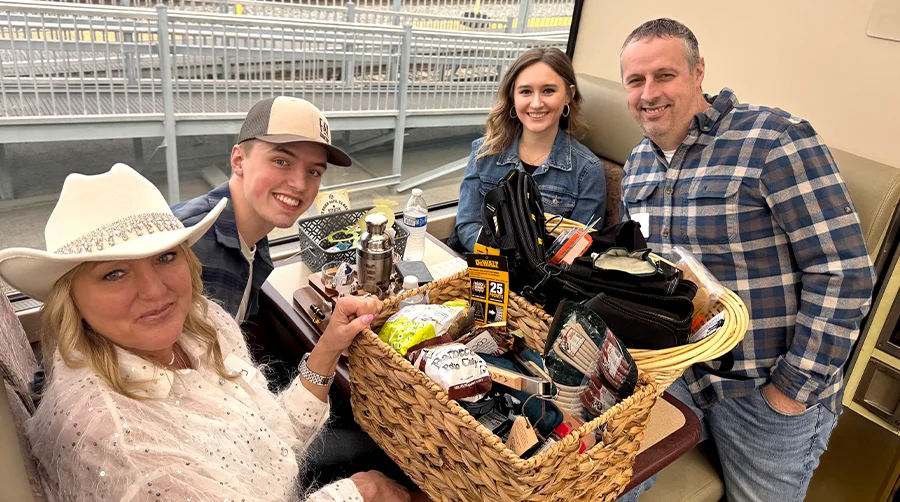


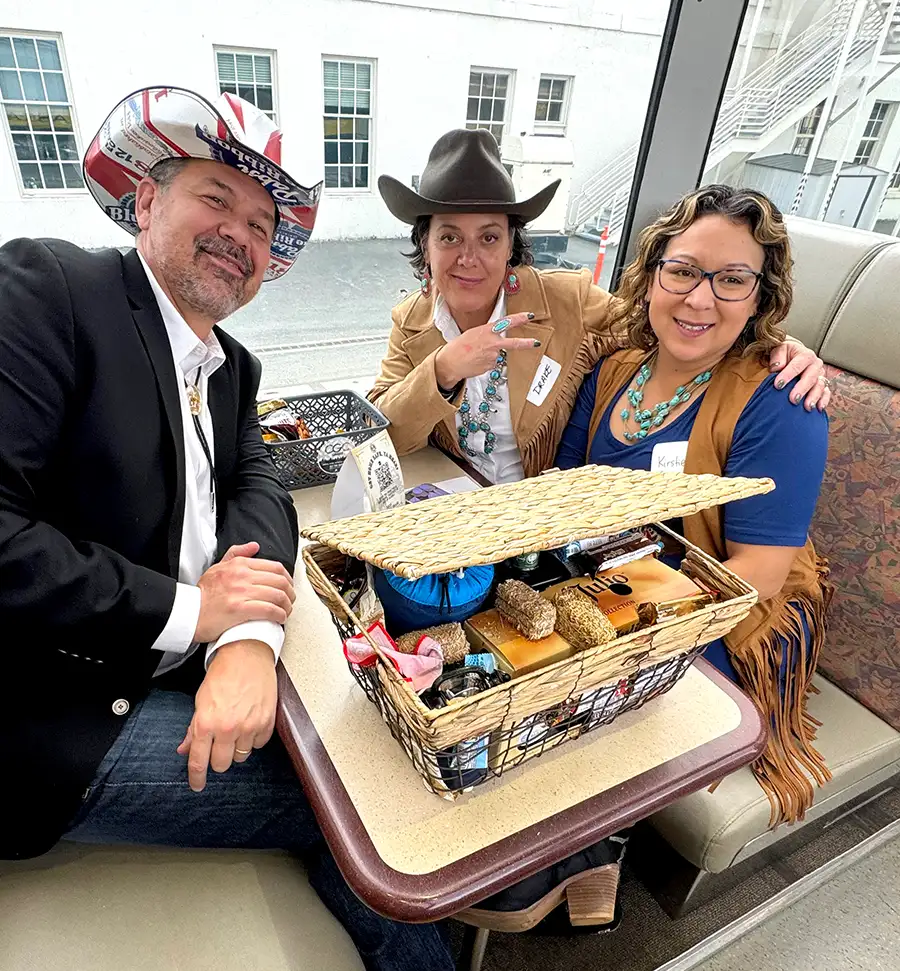
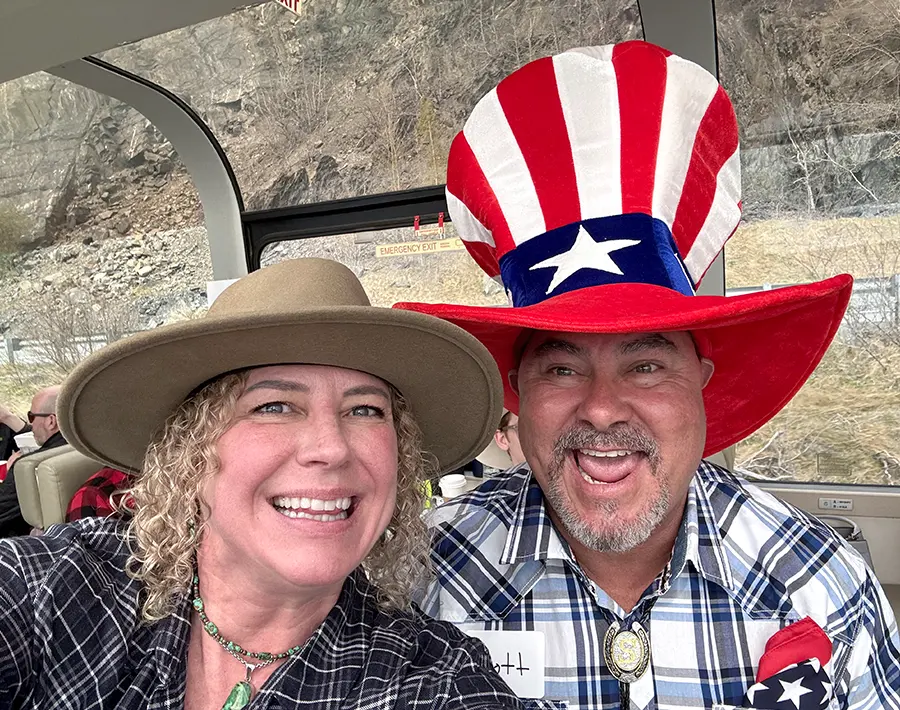

- CGC Services, LLC
- Construction Machinery Industrial, LLC (CMI)
- Granite Construction Company
- North Star Equipment Services
- Spenard Builders Supply
- Swalling General Contractors, LLC
- TOTE Maritime Alaska, Inc.
- Alaska National Insurance Company
- Drake Construction Inc.
- Marsh McLennan Agency
- Minn-Alaska Transport
- N C Machinery Co.
- Anchorage Sand & Gravel Co., Inc.
- Big State Mechanical, LLC
- Carlile
- Davis Block & Concrete
- Knik Construction Co., Inc.
- Shoreside Petroleum, Inc.
- Sourdough Express, Inc.
- Hiland Construction LLC
- Northern Air Cargo
- Ritchie Bros. Auctioneers
- Top Shelf Realty, LLC
- Aurora National Insurance (DBA Bond Babes USA)
- TDL Staffing
- Ship Creek Brewing Co.

resident Donald Trump has signed several Executive Orders related to US trade policy, including setting tariffs on imported goods from multiple countries, with the intent to protect American industries. Many countries countered by issuing their own tariffs. Together, the actions are disrupting global supply chains and have created an atmosphere of uncertainty, which is affecting many businesses in all of Alaska’s major industries, construction included.
Supply issues reach beyond Canadian lumber. “Nearly all of the aluminum that’s used in the United States comes from abroad, particularly from Canada,” says Simonson. “While a lot of aluminum goes into the automotive or aerospace industries, aluminum is important for architectural features in building. Then there is a wide range of appliances, equipment, and machinery used in the construction industry that comes from a variety of countries. Much of it comes from China, so the proposed 145 percent tariff on China— or whatever percentage it ends up being—will definitely drive up the cost of a lot of construction projects.”
The reaction from other countries to US tariffs is a primary concern for the construction and other industries, he notes.
“My biggest concern about the tariffs is not cost; construction has certainly dealt with big cost jumps in the past, most notably in the year or two following the pandemic. But I’m really concerned about what other countries are doing and what they will do in reaction to our tariffs. First, the tariffs will affect many kinds of businesses. Manufacturers that depend on imported parts or components will be less competitive just because their costs are higher. But then, if other countries put tariffs on US products, that could close the door to some of those products,” explains Simonson, adding that AGC has already seen Canadians—on their own initiative—reacting strongly to the tariffs.
Chief Economist, Associated General Contractors of America
“Immigration so far this year seems to be running at zero. While Alaska was probably getting less immigration than other states, having it totally cut off will be another hardship, as construction is more dependent on foreign-born workers than many other industries. I would suspect that for some of the seasonal jobs, that is particularly true,” says Simonson.
“Another concern is the abrupt cut-off of federal funds through the cancellation or freezing of contracts and grants for many kinds of research for all sorts of projects, not specifically for construction projects necessarily, but when the owners suddenly find they don’t have the funds to do construction to support whatever they were going to put up that building for. All of these things create a huge amount of uncertainty and cause owners, whether public agencies, investors, or companies building for their own use, to put some projects on hold,” explains Simonson. “However, for the most part, contractors have not reported that they’ve been affected yet. Recession seems to be everywhere except in the data. However, there are plenty of reports, whether news stories or corporate owner reports, that investors are holding off on investments.”
“What I hear contractors talk about is putting larger contingencies into their bids and encouraging owners to agree to earlier purchases of materials if they’re the sort of thing that can be stored,” shares Simonson. “If there is a site that can store materials, the contractors will need an agreement on who will pay for the use of that storage facility, the insurance that may be required, and the risk that the specifications or the quantity might turn out to be wrong. So many projects go through modification as they’re underway or after the initial signing of a contract. Those are some of the things that are worth discussing between owners and contractors and always worth having communication on as early and as frequently as possible between the designers, the fabricators, the contractors, and the subcontractors. While those rules apply in any case, the consequences of not following them are greater in this setting.”
To assist contractors in uncertain times, AGC of America has created several resources.
AGC has an advocacy news website at advocacy.agc.org/news, which can be a useful resource for following anything in the administration that is important to your business, including executive orders, regulations, and tariffs.
The AGC Legislative and Regulatory Priorities 2025-2026 report, found online at advocacy.agc.org/priorities, outlines federal legislative and regulatory priorities that will promote and advance the construction industry.
AGC members can stay informed by weekly newsletters from Construction Advocacy in Action. Sign up at agc.org/news/newsletter.
And finally, a frequently updated page outlining recent tariff news and helping contractors navigate challenges related to possible tariffs: agc.org/tariff-resources-contractors.
“The US economy and its construction industry have shown incredible resilience over the last five-plus years. So, while I do feel that the risk of a downturn, even a recession, has gone up a lot, I believe construction will continue to grow after what may be a rough patch,” concludes Simonson. “We’ll move on. We’ve done it before.”

t’s not often that a construction project gets completed one-and-a half years ahead of schedule, but according to SECON Project Engineer Jared Mackey, the collaboration between everyone involved in recent Juneau Airport improvements allowed them to finish in May, instead of on the projected completion date of September 2026.
“It’s not just one party that deserves praise for getting this project completed in a timely manner,” he says. “The City and Borough of Juneau’s ability to work with the airport’s tenants and contractors, and DOWL Engineers’ ability to deal with constant planning and rephasing was a big help, as was the commitment of SECON and the project’s subcontractors to working long, hard hours to complete a year and a half ahead of schedule.”
The $14.7 million project included rehabilitating the Part 121/135 apron and remaining overnight, or RON, parking apron, which were both more than thirty years old.
“The timing of the project followed the Alaska Department of Transportation’s asphalt pavement and classification, which identified the apron surfaces as needing replacement, and the apron work and RON work were combined into a single project for efficiency,” explains Juneau Airport Project Manager Mike Greene.
During the design phase of the project, the airport intentionally created a lineal schedule, identifying each of the twelve project work phases, and assigning a work period for each.
“As we had hoped, SECON elected to address the work by overlapping work phases, which allowed them to work in more than one phase area at a time, effectively shaving an entire year off of the schedule,” says Greene.
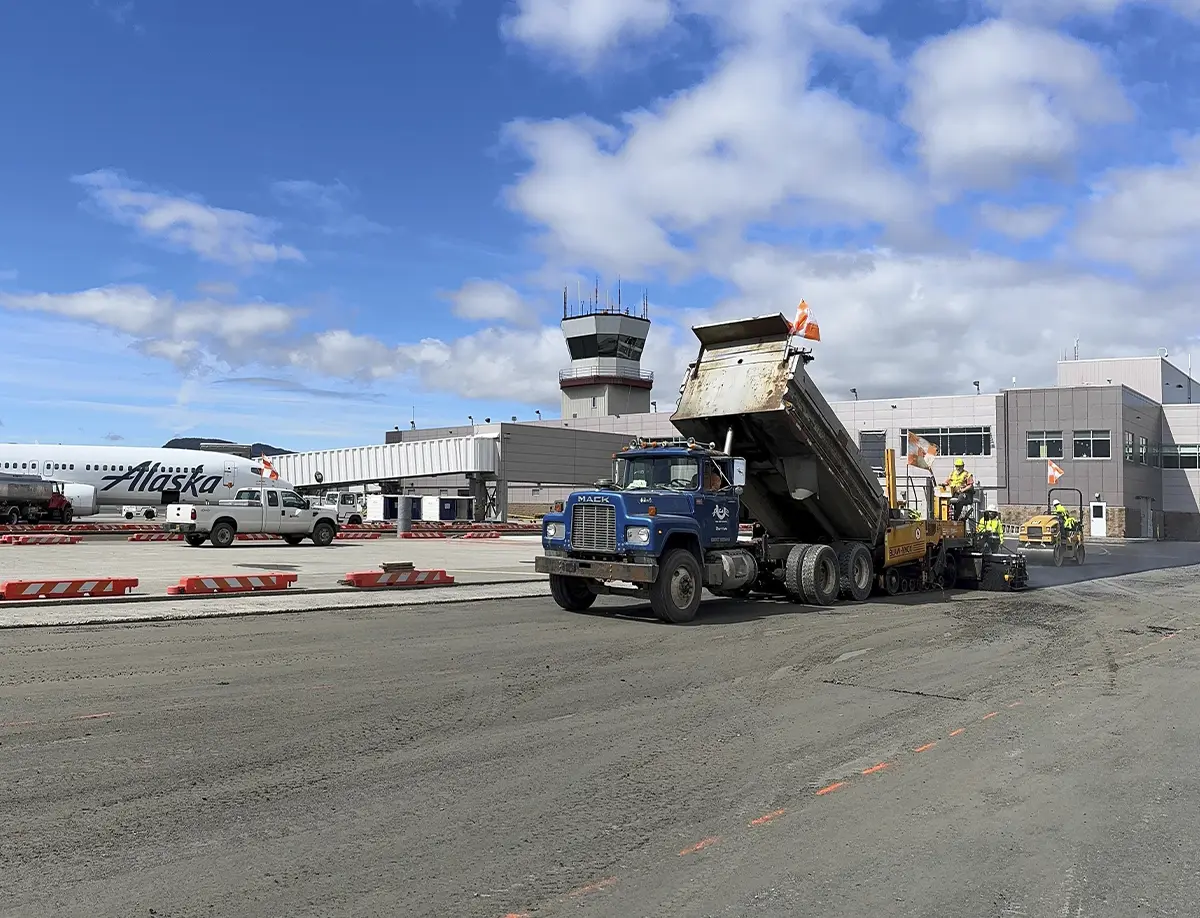
“These aprons/ramps abut one another and cover an area of approximately 23 acres. The last major rehabilitation occurred more than twenty years ago, with more recent repairs occurring in areas around the jet bridges,” says Greene. “The pavement on both aprons/ramps had been determined to be well beyond its useful life and had been showing signs of deterioration from heavy aircraft use.”
While crack sealing and temporary repairs had been done over the years as a stopgap measure, they could no longer address all areas of failing pavement, including potholes, spalling, ponding in low spots, and drainage/catch basin fatigue.
The project also addressed the existing apron lighting mounted on the south side of the terminal that created cockpit glare and cast shadows from parked aircraft that prevented the illumination of work areas around the aircraft.
“This project introduced new lighting away from the terminal near the ends of the jet bridges that will cast light directly downward to fully illuminate the areas used by ground crews,” says Greene.
“In the past, every night from late-May to mid-September, gate parking was at capacity,” says Greene, noting that air carriers often used the freighter parking across the ramp as a RON spot between freighter arrivals.
“Air carriers also towed their 737 RON aircraft to the north ramp, though the pavement was not suitable for that type of aircraft,” adds Greene. “Additionally, small aircraft parked on the outside parking spots on the 135 ramp were displaced at night to allow the 737 [aircraft] sufficient space to be towed to/from the area until a gate became available.”
Work on the RON included construction of subsurface structural subbase and base course, the installation of a reinforced concrete hardstand, the placement of asphalt paving to meet weight standards for large, scheduled passenger aircraft parking, and striping and marking associated with parking and lead-ins.
“The worn and damaged asphalt surfaces have now been replaced, which directly benefits every aircraft that traverses these aprons, as well as improves the efficiency of snow removal operations,” says Greene. “Juneau now has a dedicated hardstand for use by any aircraft that needs to overnight (without tying up a passenger boarding bridge/gate) and provides a parking position for any aircraft experiencing a mechanical [issue].”
SECON coordinated its construction work with other airport projects: JIA’s replacement of the passenger boarding bridge at Gate 5, as well as Alaska Airlines’ replacement of passenger boarding bridges at Gate 3 and Gate 4, and expansion of Alaska Airlines’ air-cargo hardstand.
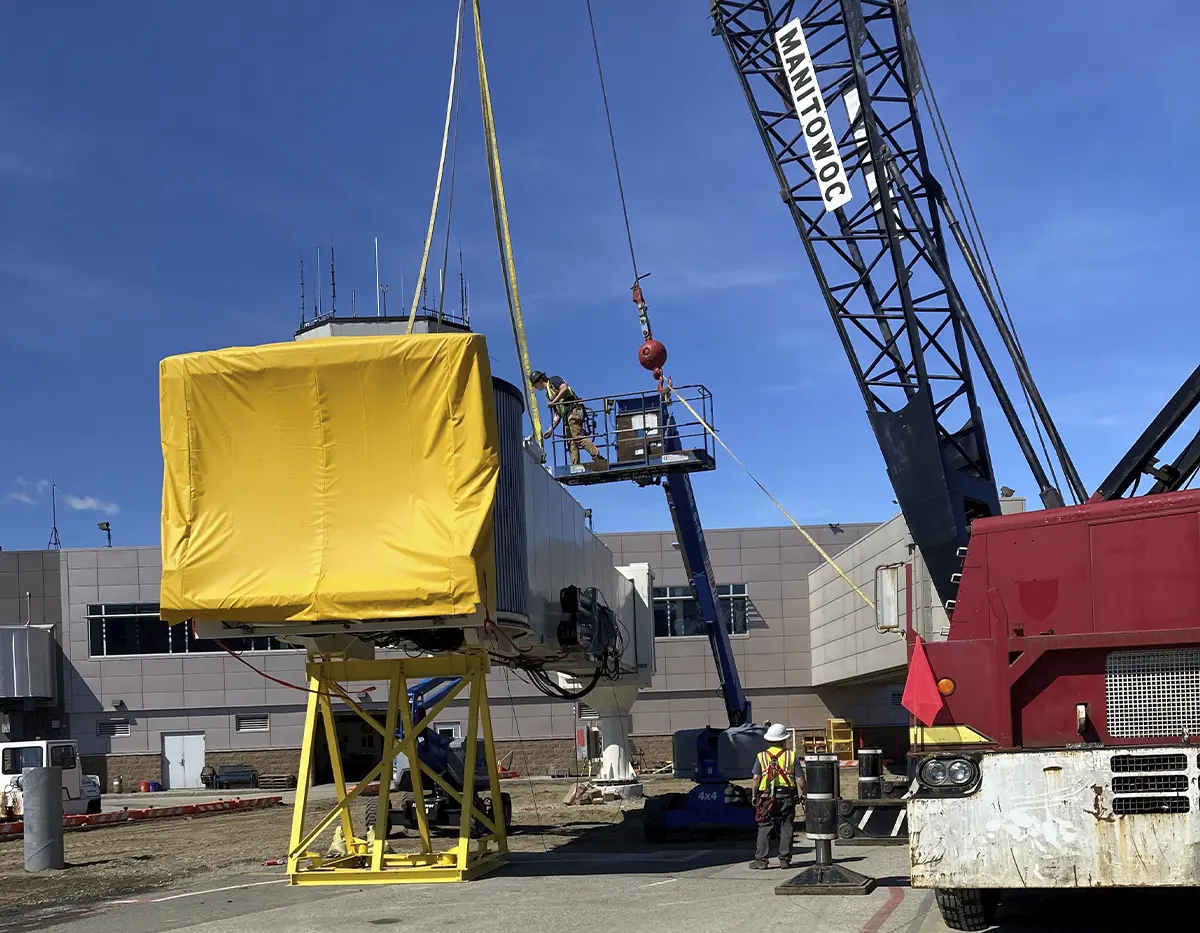
“There were numerous airport stakeholders affected by our work, including Alaska Seaplanes, Ward Air, Coastal Helicopters, Alaska Airlines, and Delta, so it took constant communication and planning to find a way to keep everyone happy,” says Mackey. “We also live in a rainforest, so we had to take advantage of non-rain days, working 14- to 18-hour days and weekends.”
SECON also took long lead times into account and started procuring the items it would need in 2023. To make sure they had enough workers, and to complete the airport improvements on time, the contractor juggled other projects.
“We have labor shortages here like they have everywhere else because the workforce is getting smaller,” says Mackey. “We only have so many union employees, and have a number of projects going on at the same time, including in Haines and Ketchikan, so we had to share our workforce. Sometimes that meant flying in certain people for different aspects of work and flying them out again when it was done.”
The full project included thirty SECON employees as well as roughly sixty subcontractor employees. Associated General Contractors, or AGC, of Alaska member companies who worked as subcontractors on the project include Compass Construction, LLC; DOWL; and Pacific Asphalt, LLC.

Photo provided by Caliber Construction Alaska


Photo provided by Caliber Construction Alaska
n the face of a global pandemic that stalled many businesses in 2020, Caliber Construction Alaska LLC turned uncertainty into opportunity. What began as a series of side projects during the COVID-19 slowdown has grown into a dynamic civil contracting firm.
Founded by Colton LeVasseur, Caliber Construction Alaska is rooted in a legacy of earthwork expertise. A fourth-generation construction industry professional, LeVasseur started his career working for his family’s business in 2009 before making the leap into Operating Engineers Local 302. He worked construction jobs in the summer and worked toward his pilot’s license in the winters, leading to a career as a commercial pilot. But in 2020 the demand for high-quality site work pulled him back to the ground for good, and Caliber was born.
“What started as small contracting jobs during the pandemic quickly grew into something much larger,” says LeVasseur. “Soon, I had to step away from flying to keep up with the volume of work. That’s when Caliber Construction Alaska really took off.”
“We’re not afraid of complex or high-risk jobs,” says LeVasseur. “Where others might walk away or add a hefty contingency, we lean in. Our skilled team, niche tools and equipment, technology, and hands-on leadership allow us to deliver exceptional results efficiently and safely.”

Photo provided by Adam Erdmann
Brian Van Abel of Swalling General Contractors, the project’s principal contractor, praised Caliber Construction Alaska’s performance.
Van Abel credits the project’s success to the two companies working closely to develop a work plan, which was carefully coordinated between the owner and military, allowing completion of the work in fewer than three months.
“Caliber’s culture of professionalism impresses me,” continues Van Abel. “Caliber shows up to the site when they say they will, they provide solutions to issues as they arise, and they execute their scope of work on time. Caliber is a trusted civil subcontractor for Swalling. We’ve completed several projects together and have several new projects starting as well.”
While Caliber Construction Alaska has proven its ability to tackle large scale infrastructure jobs, the favorite role of the company team is site preparation: getting a site ready so vertical contractors can hit the ground running.
“We love being the team that clears the way, literally and figuratively, for builders,” LeVasseur says. “We help them stay ahead of schedule and deliver high-quality foundations for successful projects.”
“There’s a real need to bring new talent into the trades,” explains LeVasseur—who is 33 years old. “We’ve built a culture where mentorship is expected. Our seasoned team members take pride in showing the ropes to the next generation.”
From hands-on leadership to smart recruitment, Caliber Construction Alaska is creating a workforce that’s as forward-thinking as the technology they use, utilizing global positioning systems and machine control.
Founder, Caliber Construction Alaska LLC

Photo provided by Caliber Construction Alaska
“We take pride in the diversity of our work and the impact we’re making in our communities,” Bates says. “We’re constantly growing, always improving, and that’s exciting to be part of. Colton has instilled a ‘roll-up our sleeves’ culture across the board. Everyone from office staff to the field hands chips [in] wherever it is needed. It’s unlike what I have witnessed in the past for this industry.”
As an Associated General Contractors, or AGC, of Alaska member since the company’s inception, Caliber Construction Alaska leaders value the relationship AGC is building across the industry.
“AGC has been a great platform for networking and collaboration,” Bates adds. “It helps us stay connected and build partnerships that matter.”
“We’re proud of what we’ve built, but we’re just getting started,” says LeVasseur. “There’s a lot of work ahead.”

n March, more than 150 high school students from across Alaska gathered in Anchorage to test their abilities in hands-on technical and leadership challenges during the state’s SkillsUSA conference. The three-day event, held March 26 through 28, marked a growing return for SkillsUSA in Alaska, as students competed in dozens of different trade competitions ranging from welding and electrical wiring to video production and cosmetology.
Winners represented Alaska at the SkillsUSA National Championships in Atlanta, Georgia, from June 23 to 27.
“The National Competition is absolutely mind-blowing,” says Keith Hodson, SkillsUSA Alaska director and a career and technical education coordinator at the Anchorage School District, of the 2024 competition. “Imagine thirty football fields filled with competitions: that’s what SkillsUSA is like. The energy is electric—young adults proudly showcasing their skills. Alaska has one of the smallest populations in the nation, and I know our students felt overwhelmed; I did too.”
“We’re so grateful to our teachers, parents, and business sponsors for making this possible,” Hodson says. “Students in these programs are learning real-world skills, building résumés, and practicing public speaking. They’re gaining confidence, and that’s priceless.”
The list of competitions spans both technical and leadership categories, from welding sculpture and diesel mechanics to job interview simulations and t-shirt design. As participation and interest increases, so will the number of competitions that are offered. According to Lori Harmon, president of the SkillsUSA Alaska board and an industry leader with GHEMM Company in Fairbanks, SkillsUSA can tailor competitions to the needs of the state.
Board President, SkillsUSA Alaska
All participating students are enrolled in Career and Technical Education, or CTE, classes. Once advisors sign up for SkillsUSA, they receive competition standards that often align closely with their existing curriculum. Hodson says the experience transforms classroom dynamics.
“Instead of resisting authority, students are now part of a team with their teacher,” he says. “They also receive praise from community members for their hard work, which rarely happens in core academic classes.”





“They go from not knowing how to run a basic meeting to leading an entire conference delegation,” Hodson says. “It’s incredible to witness.”
Hodson says students who take two or more of these types of classes have a 93 percent graduation rate, compared to the 82 percent of those who don’t. He said this is why the Anchorage School District is investing in this type of education, and why the state should consider doing the same.
“If our state government is serious about workforce development, they need to properly fund our schools so more families can access these opportunities,” he says.
Harmon notes that Alaska is projected to see a 9.8 percent increase in construction jobs by 2030.
“Through the SkillsUSA competitions, students learn skills that will allow them to find high-paying jobs in high-demand careers,” Harmon says. “We want our Alaskan students to stay in Alaska. It is not easy or cheap to live in Alaska. This is especially true for rural communities. Every community, no matter what size, needs people with trade skills. We must invest in our students to combat the outward migration in our state.”
The structure of the national competition allows only one entry per student. If a student wins in multiple categories at the state level, the second-place finisher in the overlapping categories is invited to participate at the national level, maximizing the number of Alaskans eligible to compete nationally.

“The beautiful thing about SkillsUSA is you are exposing youth to a profession in a safe manner, where the workforce isn’t taking advantage of it,” Coghill says. “The idea of getting a 14- to 16-year-old child to come work for you in a construction industry, or in a salon, or in a bakery, or in a welding shop has inherent dangers, and none of our insurance companies would allow us, but they need that exposure, right? That’s what SkillsUSA facilitates.”
Coghill, who did not graduate high school and later earned his GED before building a career in the trades, says the cultural shift away from the “college-or-failure” mindset is long overdue.
“I was told when I was in school if I didn’t go to college that I was going to be considered a failure,” Coghill says. “And I felt that… Now, looking back over the twenty-five years that I’ve been in the trade, I understand that most of those guys that went to college work for me or somebody like me, and that it has been a very lucrative skill. It’s something that I’ll take with me for the rest of my life.”
Traci Johnson, a board member with SkillsUSA Alaska, says the program’s growth this year is a hopeful sign. The competition categories evolve based on student interest, with a historic strength in construction-related trades.
The conference, powered by hundreds of volunteer hours, aims to eventually rotate among Alaska’s three largest population centers. Next year’s conference, however, will remain in Anchorage. Organizers hope to hire a permanent state director to ensure long-term sustainability.
Coghill says he hopes future competitions will see more involvement from all regions of Alaska.
“These students—not only are we teaching them how to read, write, do math—but if we’re not giving them tangible tools, as well, we’re failing them still,” he says.

Dorsey & Whitney LLP

Dorsey & Whitney LLP
he construction industry is no stranger to challenges, but the recent surge in tariffs on essential building materials—steel, aluminum, and lumber—has introduced a new level of complexity.
President Donald Trump’s second term in office has been defined, in part, by a series of sweeping trade negotiations aimed at reshoring US manufacturing and reducing trade deficits. For Alaska’s construction community, where supply chains are intricate and logistics are often remote, the financial implications are acute.
To safeguard against financial uncertainties introduced by changing tariffs, project stakeholders should select the contract pricing model appropriate for the work and caresfully negotiate provisions that shift the risk of tariffs to the party best positioned to shoulder it.
- Fixed Price Contracts: Under this model, the contractor agrees to complete the project for a predetermined price. While this model provides cost certainty for the owner, it places the risk of cost increases—such as those arising from tariffs—entirely on the contractor. Absent specific contractual provisions addressing tariff-related cost escalations, the contractor may be compelled to absorb such increases, potentially impacting profitability.
- GMP Contracts: In a GMP arrangement, the owner reimburses the contractor for its actual costs incurred plus a fee, with the total not exceeding a specified maximum price. If tariffs suddenly raise material costs, contractors may be forced to absorb the difference, threatening their profitability on the project.
Because both pricing models are premised on setting a ceiling for the cost of the work, it is imperative to address tariff-related risks during contract negotiations, as many standard construction contracts (i.e., American Institute of Architecture forms) are silent on how to manage such risks. As a result, it is common for parties to revise certain contract provisions to address specific issues, including potential impacts and work delays caused by tariffs.
- Advanced Procurement: For projects with long lead times, early procurement of materials can help avoid delays and mitigate the impact of future tariff increases. Contracts should specify procurement timing, storage responsibilities, and insurance requirements. In Alaska, where delivery logistics are complex, early procurement is a prudent strategy to avoid seasonal or tariff-driven cost spikes. Parties should confer with their insurance broker to determine whether their builder’s risk policy covers materials in transit or stored off-site. If not, stakeholders may want to consider purchasing additional coverages to ensure that long lead items are insured before they arrive at the project.
- Contingency Clauses: Incorporating a contingency clause allows parties to agree to increase the overall contract price by a specified amount when certain events occur, such as material price escalations due to tariffs. If the contingency is not exhausted, savings are typically shared between the owner and contractor. This provision helps distribute the risk of price uncertainty between both parties.
- Change-in-Law Provisions: Tariffs are often categorized as changes in the law. Including a change-in-law provision in contracts allows for adjustments if new tariffs are enacted after the contract’s execution. This provision enables contractors to shift the risk of price increases due to new laws to the owner. To ensure entitlement to such adjustments, contractors should ensure that the contract’s change-in-law provisions explicitly include tariff language.
- Force Majeure Clauses: Force majeure clauses often cover events labeled as “acts of god,” and include both natural and man-made events like fires, floods, storms, war, and labor strikes. These provisions shift the risks associated with certain unforeseeable events that are not the fault of either party. It is common for these provisions to only address time impacts and not price adjustments. Like other force majeure events, changing tariffs can cause both delays and cost impacts to contractors. Savvy parties should consider including tariff-specific language in their force majeure provisions and specify whether the contractor is entitled to additional time and compensation if tariffs impact the work.
For additional support navigating changes in trade policies, members can access the Associated General Contractors of America’s Tariff Resource Center at agc.org/tariff-resources-contractors. This online portal is tailored to the construction industry’s needs and includes educational materials, a memorandum outlining strategic approaches for managing price escalations and contractual adjustments, and model contract provisions.

ssociated General Contractors, or AGC, of Alaska awarded scholarships to twenty recipients this year, disbursing more than $40,000 to degree-seeking students and to students learning a trade. Congratulations to the recipients, and thank you to all who donated to the scholarship fund to make it possible.
Living in a remote island community in southeast Alaska and the challenges I faced growing up have taught me resilience, independence, and how to work hard with limited resources. I’m a stronger and more determined person because of it. I’ll be the first in my family to graduate high school and attend college, and my goal is to return to Alaska to design buildings and structures that serve rural and coastal communities.
The AGC of Alaska Scholarship has opened the door for me and is making it possible for me to attend college without financial stress. I’m genuinely thankful to AGC of Alaska for investing in students like me, helping create opportunities for Alaska’s future builders and developing our state’s infrastructure.
Lastly, I thank my Uncle Joe Brown for being my load-bearing beam—holding me up, reinforcing my foundation, and guiding me as I draft the blueprint of the future I’m building.
I will be attending the UAF College of Engineering and School of Mines. It is important to note that I would not be able to fully and passionately pursue an education and career in construction and engineering without this generous award that I have been extremely privileged and fortunate to receive from the Alaska AGC. This award will allow me to take full advantage of the amazing internship, work-experience, and travel opportunities offered at UAF to broaden and further my education in engineering and construction without the added distractions of financial burden. I want to develop the knowledge and hands-on skills to become an effective and knowledgeable employee in our state’s construction industry in order to meaningfully contribute to the economic future of our majestic state, and I am extraordinarily grateful and honored that the AGC chose to help me fulfill this quest.
My junior year, I was given a great opportunity to work as an intern to civil engineers at McLane Consulting, Inc. During my internship, I got to learn and see a lot about the field. This job helped to solidify my decisions for the future, and I owe a lot to them for the support and opportunities they have given me. During college I intend to work hard to get my degree and more field experience along the way. After college I want to move back to Alaska and work in the great state doing what I can to improve the infrastructure we use in our everyday lives. I am ever grateful to AGC that I am one of the recipients of their scholarship. This money helps to give me opportunities to receive a higher education. I also want to thank them for the continued support of Alaska’s youth.
I obtained my Class A commercial driver’s license in 2024 while I was six months pregnant; a goal I had set and revisited many times in my life. Something about the whistling sounds of the turbo while shifting gears sparked my interest in the working mechanics of the truck, incidentally setting my trajectory on a new path.
I’ve always had a passion and admiration for big rigs along with their drivers and the mechanics who keep them on the road. With the help of AGC, I will be embarking on a new endeavor to pursue diesel/heavy equipment technologies at Alaska Vocational Technical Center, or AVTEC, in Seward. Thank you so much to AGC for this scholarship opportunity to build upon my commercial driving career and educational goals.

Environmental Management
n Automated External Defibrillator, or AED, is a portable medical device designed to restore normal heart rhythm in individuals experiencing sudden cardiac arrest. It analyzes the heart’s rhythm and, if necessary, delivers an electric shock, or defibrillation, to help the heart re-establish an effective rhythm.
Sudden cardiac arrest, or SCA, is the third leading cause of death worldwide. Construction sites, with their inherent physical and environmental risks, are particularly vulnerable to such emergencies. The deployment of AEDs on these sites is not merely a precautionary measure but a critical component of a comprehensive safety strategy. AEDs offer multiple benefits, from saving lives to ensuring compliance with regulations and fostering a culture of safety.
SCA occurs when the heart’s electrical system malfunctions, causing an abrupt cessation of effective heartbeat. Without immediate intervention, brain damage can begin within four minutes, and death is likely within ten minutes. AEDs are designed to deliver an electric shock that can restore normal heart rhythm, often before emergency medical services, or EMS, arrive. On construction sites where access to EMS may be delayed due to remote locations or complex site layouts, AEDs bridge this critical gap. After multivariate analysis, the AED was found to have provided a 1.75-fold greater likelihood of survival for those experiencing SCA, according to a 2010 paper published by the American Clinical and Climatological Association.
The presence of AEDs also boosts worker confidence and morale. Knowing that life-saving equipment is readily available fosters a sense of security, which can improve productivity and reduce anxiety in high-stress environments. Training workers to use AEDs, often in conjunction with cardiopulmonary resuscitation, or CPR, empowers them to act decisively in emergencies, transforming bystanders into potential lifesavers.
The training is straightforward, as modern AEDs are user-friendly, with voice prompts and visual guides that require minimal medical knowledge. For example, devices like the Philips HeartStart or ZOLL AED Plus are designed for layperson use, ensuring that even untrained workers can operate them effectively under pressure.
Furthermore, AEDs can mitigate the financial and operational impacts of workplace incidents. SCA events without prompt intervention often result in fatalities, leading to costly legal battles, workers’ compensation claims, and project delays. By contrast, a successful AED intervention can minimize these consequences, preserving both human lives and business continuity. The cost of AEDs—typically $1,000 to $2,000 per unit—is modest compared to these potential losses, making them a cost-effective investment.
Clear and visible signage should also indicate the location of AEDs, making them easy to find during an emergency, and they should be regularly inspected and maintained to ensure they are in proper working order and ready for use.
Incorporating information about heart health and the warning signs of cardiac arrest into regular safety briefings would help prepare workers for these emergencies.
AEDs are a vital asset on construction sites, offering rapid, life-saving intervention, ensuring compliance, and enhancing worker well-being. Their integration into safety protocols reflects a proactive approach to managing the unique risks of construction environments, ultimately creating safer and more resilient workplaces.
- Familiarize yourself. Learn how to operate an AED and always know its location in case of an emergency. If you know CPR, don’t let the automated AED instructions slow you down, but always clear the victim when the AED is analyzing or advising shock be delivered. Once you open an AED, it provides verbal instruction to the user and is easy to operate.
- Ensure the scene is safe. Check if the person is unresponsive and not breathing normally, such as gasping or not breathing. If so, call emergency services or 911, or have someone else call.
- Turn on the AED. Retrieve the AED, open it, and press the power button. Most AEDs provide voice or visual prompts to guide you.
- Apply the pads. Expose the person’s chest (wipe it dry if wet). Peel the adhesive pads from the packaging and place them as shown on the pads or AED instructions—typically one on the upper right chest and one on the lower left side.
- Analyze the heart rhythm. Ensure no one is touching the person. The AED will automatically analyze the heart rhythm and determine if a shock is needed. Follow prompts to press the “analyze” button if required.
- Deliver a shock (if prompted). If the AED advises a shock, ensure no one is touching the person (say “Clear!”). Press the shock button when instructed. If no shock is needed, proceed to CPR.
- Perform CPR. After a shock—or if no shock is advised—begin CPR with chest compressions at 100 to 120 beats per minute, about 2 inches deep for adults. Continue until the AED prompts another analysis or emergency personnel arrive.
- Follow AED prompts. The AED will guide you, re-analyzing the heart rhythm every two minutes or as needed. Follow its instructions until help arrives or the person shows signs of life.
Photo provided by National Association of Women in Construction
Photo provided by National Association of Women in Construction Alaska Chapter
or twenty years the National Association of Women in Construction, or NAWIC, has celebrated, promoted and educated the public about the role of women in the industry with Women in Construction Week, held in March. Locally, Alaska’s NAWIC chapter highlights the achievements of women who work across all fields of the industry with the Constructive Women Award.
This year, seventeen women were nominated by their peers. Of the six Constructive Women Award winners, five were from Associated General Contractors, or AGC, of Alaska member companies.
We reached out to each of them to learn more about their achievements, how they navigate the changing landscape of Alaska’s construction industry—and what advice they have for future “constructive” women.
Director,
Alaska Laborers Training School
Apprentices in the program get paid while they learn on the job; meanwhile, contractors “benefit by having a steady, well-trained and skilled workforce,” says McCarthy. The state benefits as a whole, too, since students mostly engage in public works projects such as building highways, bridges, ports, and more.
McCarthy is passionate about recruiting even more people into the construction industry—particularly women.
“Women always get paid equally in construction, which is not true for so many other career pathways,” she says.
As a member of NAWIC, she says she is part of a “group of strong women who work in today’s industry and are paving the way for other women to enter and advance.”
She highlights NAWIC’s mission of increasing recruitment, retention, and development of women in construction. “I am boots-on-the-ground, making that happen throughout Alaska,” she says.
Superintendent,
HC Contractors
Fast-forward to today: She’s overseeing large-scale road construction projects, working on overpasses and complex at-grade interchanges like the Gaffney Road/Airport Way/Richardson Highway/Steese Expressway, or GARS, project—which HC Contractors completed in almost half the projected time.
“That’s a career highlight,” Kuykendall says. “Putting together a crew that can accomplish goals is key, [and] I have a pretty great team here at HC.”
The work Kuykendall’s team did on the GARS project exemplifies her expertise. With more than 26,000 vehicles crossing the project every day, as well as significant design challenges, Kuykendall not only delivered the work a year ahead of schedule but ensured continuous safe access for the public throughout construction.
In her short tenure with HC Contractors—just four years—Kuykendall has overseen and completed complex heavy civil projects in the Fairbanks area, exceeding $74 million in contract revenue. She was singled out by her nominators for her ability to lead under pressure, prioritize safety, and integrate the latest construction technology to drive performance.
When asked for advice for other women wanting to work in the field, she shares, “I would have a lot to say. But in short, I’d tell them: Respect yourself and the people you work with.”
Journeyman Electrician,
Alaska Native Tribal Health Consortium
She’s also an inspiration, not just to women who might consider a career in construction but to Alaska Native men and women who, like her, are faced with the challenge of how to get much-needed, basic health and safety services to their remote villages.
Ayapan is a living example of how to pursue a career and care for her hometown: she plays a crucial role in building water and wastewater projects that reduce the incidence of infection in remote Alaska. Through her work, more than 350 homes in rural Alaska now have safe drinking water.
Projects Ayapan has led and worked on have eliminated the need for residents of villages like Akiakchak, New Stuyahok, and Koyuk to haul water and use honey buckets.
Thanks to an appearance in a short film aimed at inspiring students in rural schools to consider construction careers, Ayapan is motivating a new generation of potential trade workers. One young woman from Tunanak specifically cited Ayapan as the reason she’s now pursuing a career as an electrician.
Principal Electrical Engineer,
RSA Engineering
Today, she leads projects that deliver technically advanced and reliable electrical design to a number of sectors, including healthcare, retail, housing, and mixed-use facilities. She also provides electrical engineering solutions to education, government, and industrial markets.
One of her most notable jobs was representing RSA as an on-site construction inspector for the US Navy at the South Pole in Antarctica in 2001;there, she designed electrical systems for the Cryogen and Balloon Inflation Facilities. She was repeatedly asked by the US Navy to return and ultimately completed three tours, earning the respect of her peers for her meticulous attention to detail and ability to excel in extreme conditions.
“Define what you want to achieve in your career and create a roadmap to reach those goals,” Ta advises other women entering the construction industry. “Find a mentor who can offer guidance, support, and advice based on their won experiences.”
Ta acts as a mentor and guide herself, fostering professional development opportunities for her team. Early on, she led and trained teams of young engineers at RSA, some of whom went on to become part of the firm’s leadership.
She continues to play a key role in developing RSA Engineering’s next generation of electrical engineers, sharing her expertise and her experience as the firm’s first female electrical engineer. A trailblazer who has worked on RSA’s most complex projects, Ta notes, “[It’s important] to trust your abilities and skills, then define what you want, keep learning—and prioritize your own well-being.”
Operations Manager,
Ahtna Infrastructure & Technologies, LLC
She never thought she’d work in construction. But when she took an administrative job with Ahtna’s Environmental group, she discovered she liked problem solving and enjoyed the challenges the field presented her; soon, she says, she was deliberately pursuing a career “where I could see the results of my work and feel like I was contributing to something bigger.”
Today, Ford manages the construction efforts for nine different companies under Ahtna Diversified Holdings. She supervises staff deployment, travel, lodging, and—above all—safety in support of project delivery in some of the most remote locations in Alaska, including locales in the Aleutian Chain and around the Pacific Rim.
The people she works with mean the most to Ford. “Creating a team that’s safer and stronger is what motivates me every day. It’s the connections we make and the way we support each other that really matters. I am proud of the contributions I’ve made here in creating a culture where everyone feels like they matter.”
Ford’s role as “the glue that holds the company together,” as her nominators characterized her, is evident in the care she puts into ensuring every individual is supported. Her nominators highlighted one instance when she acted quickly to help a remote employee who was struggling with mental health issues to evacuate from the project site and find treatment, then seamlessly return to work when they were ready.
Ford’s advice for other women in the industry reflects her natural empathy. “Your presence matters more than you know. Your work product will speak for itself—but don’t be afraid to speak up, too. And if you ever find yourself wondering whether you belong—trust me, you do.”
Congratulations to all the Constructive Women of 2025, including UIC Nappairit Project Engineer/Manager Brianna Carlson, who are paving the way for more opportunities for more women in construction.
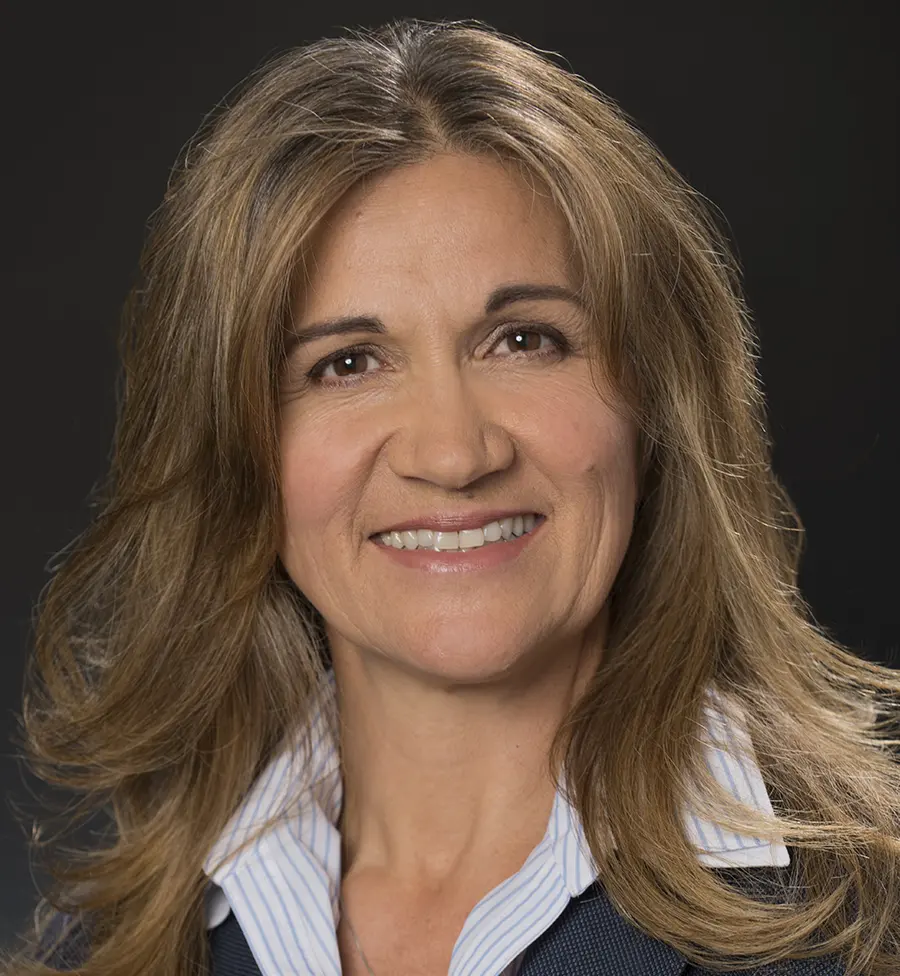
TDL Staffing
veryone keeps asking, “Where did the employees go? Why can’t we find people to fill our positions?” Today, I would like to offer hope for filling our needs as employers. The workforce suffered a sudden shift due to the COVID-19 pandemic. Since 2020, the workforce has started to improve, but it has not reached its full potential.
Of the workforce in skilled trades, 90 percent are men between the ages of 24 and 54 years old. The following trades in particular have a workforce primarily comprised of men:
- Plumbers: 98 percent
- Construction equipment operators: 97 percent
- Highway maintenance: 96 percent
- Welders: 94 percent
- Machinist: 95 percent
- Electrician: 97 percent
Women, who are more than capable of doing the work for many trades, are an as-of-yet untapped resource. During World War II, women were called to fill pilot and manufacturing positions because there were not enough men to fill the roles. Women are able to fill many roles in the skilled labor field, though it would require a change in culture to happen. That cultural shift starts with employers and educating our youth about opportunities.
The younger generations are tech-savvy. They have also watched their parents and grandparents work hard to make a living, even at the expense of family relationships. Many do not want that life. They are driving a cultural shift in increased work/life balance. Flexible schedules and hybrid work environments may be one way to attract and keep employees.
Wages were a factor in Alaska’s population loss. Alaska used to be the leader in wages, compared to the cost of living. Over the years, we have dropped to 8th in the United States. During COVID-19, wages increased in Alaska, and they have not dropped. Employers had to pay more—and still do—to get good employees.
The good news is that the population showed an increase in 2023 and 2024, and we are now almost back to the population of 2016. In the staffing industry, we have also noticed a change in the ability to find qualified candidates. It is starting to get easier to find the people needed to fill positions.
Staffing companies can be a solution to helping employers meet their staffing needs. Staffing companies do this daily—they are the professionals at it. Suppose we utilize all our resources and work with our community to continue to attract new people to Alaska. Alaska can be a great place to work, play, and live.

rice Environmental Services Corporation was honored twice in one week with Excellence in Safety awards. On April 9, the company was recognized in Anchorage at the 43rd Annual Governor’s Safety and Health Conference with the 2025 Alaska Governor’s Safety Excellence Award, presented to organizations demonstrating distinction in safety and health of their personnel, the environment, assets, and reputation that demonstrate and promote superior corporate citizenship.
offman Engineers announced in May that Cynthia Cacy, a corrosion control engineering principal at Coffman, and Zack Wright, a senior engineer at Coffman, successfully earned their Cathodic Protection, or CP, Specialist certification. In March, the company announced Patrick Rider had earned his professional engineering, or PE, license in electrical engineering.
The CP Specialist is the highest level of certification in the field of cathodic protection issued by the Association for Materials Protection and Performance. This accomplishment reflects their dedication, experience, and knowledge in the industry.
unior Achievement of Alaska announced in April that its 2026 Alaska Business Hall of Fame laureates includes Meg Nordale, president of GHEMM Company, Inc. in Fairbanks. Nordale is an Associated General Contractors, or AGC, of Alaska Life Board member, AGC National Governor and 2021 Hard Hat awardee. GHEMM and Nordale were recognized last year as Association of Fundraising Professionals’ 2024 Outstanding Small Business in Philanthropy.
GC of America President Tom Brown on April 10 awarded AGC member company ChemTrack Alaska the 2025 Baldwin Group Build America Merit Award for its Environmental Remediation Debris Services project at the Former Cape Prince of Wales Naval Field Station in Wales.
The national honor followed a local win for the same project: ChemTrack received the Excellence in Construction for a Specialty Contractor for a Job Between $1 Million and $5 Million award for the same project from the AGC Alaska Chapter in November 2024.
ettisworth North president Tracy Vanairsdale recently announced that project manager and senior architect David Popiel has been named a principal at the architecture firm. Popiel is a licensed architect with nineteen years of experience and has practiced in Alaska since 2009.
“David’s creative mindset and design sensibility help deepen our culture of collaboration,” says Vanairsdale. “We are a legacy firm shaped by shared purpose and a passion for building strong Alaska communities. David brings multi-dimensional design skills and a gift for mentoring. His thoughtful approach will strengthen our company’s leadership and support our mission to create community-centered spaces.”
ave Whitfield joined R&M Consultants, Inc. as a senior planner in the firm’s newly established land development group. He brings more than twenty years of land-use planning experience to R&M, most recently serving as the planning and zoning manager and platting officer for the Municipality of Anchorage. His background includes expertise in land-use planning, subdivision and platting, code analysis, private development, and code compliance and implementation for public- and private-sector projects.
att Melton, a C-suite professional and operational strategist, joined Republic Services of Alaska in May as its general manager. Melton will oversee the strategy and execution of Republic Services’ Environmental Solutions business in the Alaska area, which includes a network of emergency response personnel, service centers, and hazardous waste facilities.
“The work we do is essential to keeping Alaska’s communities clean and safe, and it’s an honor to join a team with such a strong reputation for safety, service, and environmental stewardship,” Melton says. “I look forward to being part of the solution to the unique environmental challenges in our region.”
- Alaska Industrial Hardware
- Alaska Mechanical Contractors Association, Inc.
- Alaska Railroad
- Alaska Steel
- Alyeska Tire
- Anchorage Chrysler Dodge
- Anchorage Sand & Gravel
- Birch Horton Bittner & Cherot
- Bob’s Services, Inc.
- Chugach Electric Association Inc.
- Construction Machinery Industrial
- Cornerstone General Contractors
- Craig Taylor Equipment
- Crowley Fuels
- Davis Block & Concrete
- Davis Constructors & Engineers Inc.
- Denali Industrial Supply
- DesertAir Alaska
- Dorsey & Whitney LLP
- Drake Construction
- ENSTAR Natural Gas Co.
- Equipment Source, Inc.
- F&W Construction Company Inc.
- First National Bank Alaska
- Fountainhead Development
- Fullford Electric, Inc.
- GMG General, Inc.
- Great Northwest Inc.
- Hamilton Construction Alaska
- IMA Financial Group
- JD Steel Co. Inc.
- KLEBS Mechanical
- Loken Crane, Rigging and Transport
- Lynden
- Matson Inc.
- Michels Corporation
- MT Housing Inc.
- N C Machinery
- NECA Alaska Chapter
- Nortech Environmental & Engineering
- Northern Air Cargo
- Northrim Bank
- Personnel Plus Employment Agency
- PND Engineers Inc.
- R & M Consultants Inc.
- Rain for Rent
- Rain Proof Roofing
- Rural Energy Enterprises
- Samson Tug & Barge
- Seatac Marine
- Sheet Metal Inc.
- Shoreside Petroleum
- SMS Equipment
- SMS Equipment
- Sourdough Express, Inc.
- Span Alaska Transporation LLC
- Spenard Builders Supply
- Sullivan Water Wells
- Surveyors Exchange Co. Inc.
- Swalling General Contractors, LLC
- Think Office
- TOTE Maritime Alaska LLC
- Tutka, LLC
- University of Alaska Office of Public Affairs
- Weaver Brothers Inc.
- Yukon Equipment Inc.




